Hospitality Management: Paris Tourism Policy and Fullerton Hotel Singapore
VerifiedAdded on 2023/06/08
|22
|5503
|260
AI Summary
This article discusses the Paris tourism policy and its impact on the economy and society. It explores sustainable tourism and Butler's Lifecycle Model. Additionally, it delves into the history and background of the Fullerton Hotel Singapore and its economic and social impacts. The article concludes with recommendations for sustainable tourism.
Contribute Materials
Your contribution can guide someone’s learning journey. Share your
documents today.
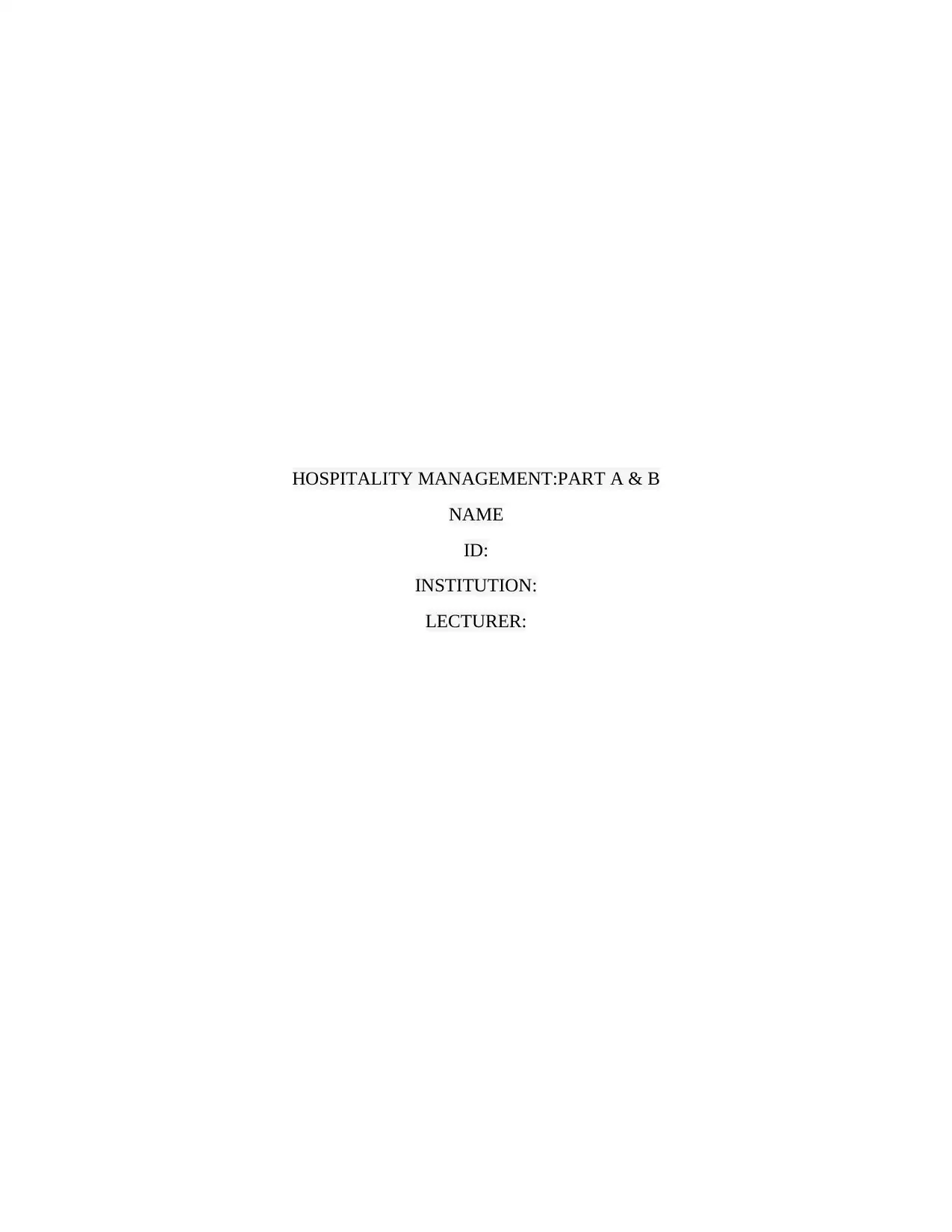
HOSPITALITY MANAGEMENT:PART A & B
NAME
ID:
INSTITUTION:
LECTURER:
NAME
ID:
INSTITUTION:
LECTURER:
Secure Best Marks with AI Grader
Need help grading? Try our AI Grader for instant feedback on your assignments.

Hospitality Management 2
Table of Contents
PART A
:HOSPITALITY MANAGEMENT................................................................................................3
Paris Tourism policy........................................................................................................................4
1.Enviroment............................................................................................................................5
2.Social-culture.........................................................................................................................6
3. Economic..............................................................................................................................7
Discussion....................................................................................................................................7
Butler S Lifecycle Model.............................................................................................................8
Recommendation: Agenda 21....................................................................................................10
Conclusion.....................................................................................................................................11
PART B: THE FULLERTON HOTEL SINGAPORE..................................................................12
History and Background................................................................................................................12
Impact of the Fullerton Hotel........................................................................................................15
Economic impact...........................................................................................................................15
Social impacts............................................................................................................................16
Gunn’s Theory model................................................................................................................17
Conclusion.................................................................................................................................18
References......................................................................................................................................19
List of figures
Figure 1: The five stages of butler Model…………………………………………………….9
Figure 2: Gunn’s Tourism Functioning System………………………………………………17
List of photos
Photo 1: The Fullerton Building 1913…………………………………………………………13
Photo 2: $400 million-dollar ongoing renovation in 1998………………………………….….14
Table of Contents
PART A
:HOSPITALITY MANAGEMENT................................................................................................3
Paris Tourism policy........................................................................................................................4
1.Enviroment............................................................................................................................5
2.Social-culture.........................................................................................................................6
3. Economic..............................................................................................................................7
Discussion....................................................................................................................................7
Butler S Lifecycle Model.............................................................................................................8
Recommendation: Agenda 21....................................................................................................10
Conclusion.....................................................................................................................................11
PART B: THE FULLERTON HOTEL SINGAPORE..................................................................12
History and Background................................................................................................................12
Impact of the Fullerton Hotel........................................................................................................15
Economic impact...........................................................................................................................15
Social impacts............................................................................................................................16
Gunn’s Theory model................................................................................................................17
Conclusion.................................................................................................................................18
References......................................................................................................................................19
List of figures
Figure 1: The five stages of butler Model…………………………………………………….9
Figure 2: Gunn’s Tourism Functioning System………………………………………………17
List of photos
Photo 1: The Fullerton Building 1913…………………………………………………………13
Photo 2: $400 million-dollar ongoing renovation in 1998………………………………….….14
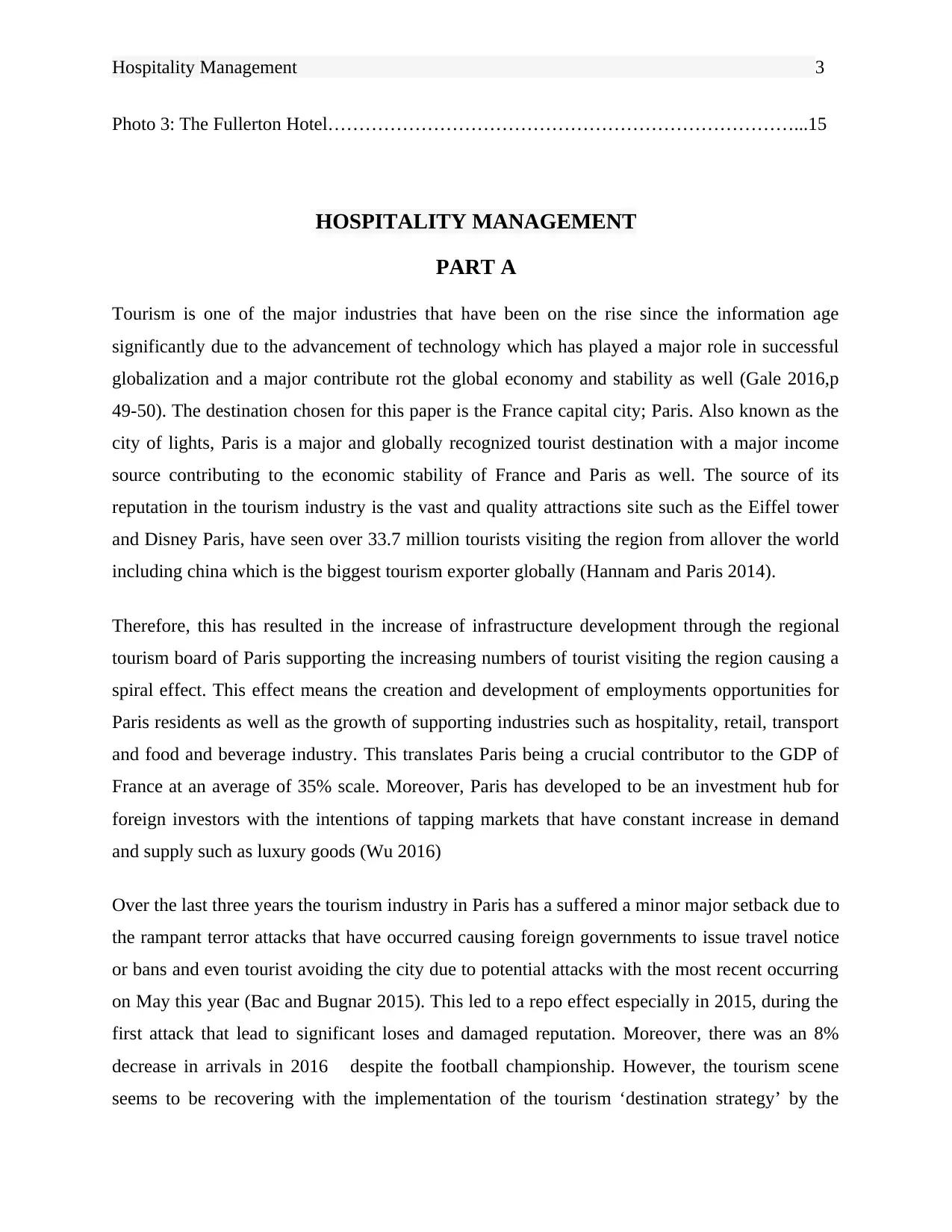
Hospitality Management 3
Photo 3: The Fullerton Hotel…………………………………………………………………...15
HOSPITALITY MANAGEMENT
PART A
Tourism is one of the major industries that have been on the rise since the information age
significantly due to the advancement of technology which has played a major role in successful
globalization and a major contribute rot the global economy and stability as well (Gale 2016,p
49-50). The destination chosen for this paper is the France capital city; Paris. Also known as the
city of lights, Paris is a major and globally recognized tourist destination with a major income
source contributing to the economic stability of France and Paris as well. The source of its
reputation in the tourism industry is the vast and quality attractions site such as the Eiffel tower
and Disney Paris, have seen over 33.7 million tourists visiting the region from allover the world
including china which is the biggest tourism exporter globally (Hannam and Paris 2014).
Therefore, this has resulted in the increase of infrastructure development through the regional
tourism board of Paris supporting the increasing numbers of tourist visiting the region causing a
spiral effect. This effect means the creation and development of employments opportunities for
Paris residents as well as the growth of supporting industries such as hospitality, retail, transport
and food and beverage industry. This translates Paris being a crucial contributor to the GDP of
France at an average of 35% scale. Moreover, Paris has developed to be an investment hub for
foreign investors with the intentions of tapping markets that have constant increase in demand
and supply such as luxury goods (Wu 2016)
Over the last three years the tourism industry in Paris has a suffered a minor major setback due to
the rampant terror attacks that have occurred causing foreign governments to issue travel notice
or bans and even tourist avoiding the city due to potential attacks with the most recent occurring
on May this year (Bac and Bugnar 2015). This led to a repo effect especially in 2015, during the
first attack that lead to significant loses and damaged reputation. Moreover, there was an 8%
decrease in arrivals in 2016 despite the football championship. However, the tourism scene
seems to be recovering with the implementation of the tourism ‘destination strategy’ by the
Photo 3: The Fullerton Hotel…………………………………………………………………...15
HOSPITALITY MANAGEMENT
PART A
Tourism is one of the major industries that have been on the rise since the information age
significantly due to the advancement of technology which has played a major role in successful
globalization and a major contribute rot the global economy and stability as well (Gale 2016,p
49-50). The destination chosen for this paper is the France capital city; Paris. Also known as the
city of lights, Paris is a major and globally recognized tourist destination with a major income
source contributing to the economic stability of France and Paris as well. The source of its
reputation in the tourism industry is the vast and quality attractions site such as the Eiffel tower
and Disney Paris, have seen over 33.7 million tourists visiting the region from allover the world
including china which is the biggest tourism exporter globally (Hannam and Paris 2014).
Therefore, this has resulted in the increase of infrastructure development through the regional
tourism board of Paris supporting the increasing numbers of tourist visiting the region causing a
spiral effect. This effect means the creation and development of employments opportunities for
Paris residents as well as the growth of supporting industries such as hospitality, retail, transport
and food and beverage industry. This translates Paris being a crucial contributor to the GDP of
France at an average of 35% scale. Moreover, Paris has developed to be an investment hub for
foreign investors with the intentions of tapping markets that have constant increase in demand
and supply such as luxury goods (Wu 2016)
Over the last three years the tourism industry in Paris has a suffered a minor major setback due to
the rampant terror attacks that have occurred causing foreign governments to issue travel notice
or bans and even tourist avoiding the city due to potential attacks with the most recent occurring
on May this year (Bac and Bugnar 2015). This led to a repo effect especially in 2015, during the
first attack that lead to significant loses and damaged reputation. Moreover, there was an 8%
decrease in arrivals in 2016 despite the football championship. However, the tourism scene
seems to be recovering with the implementation of the tourism ‘destination strategy’ by the
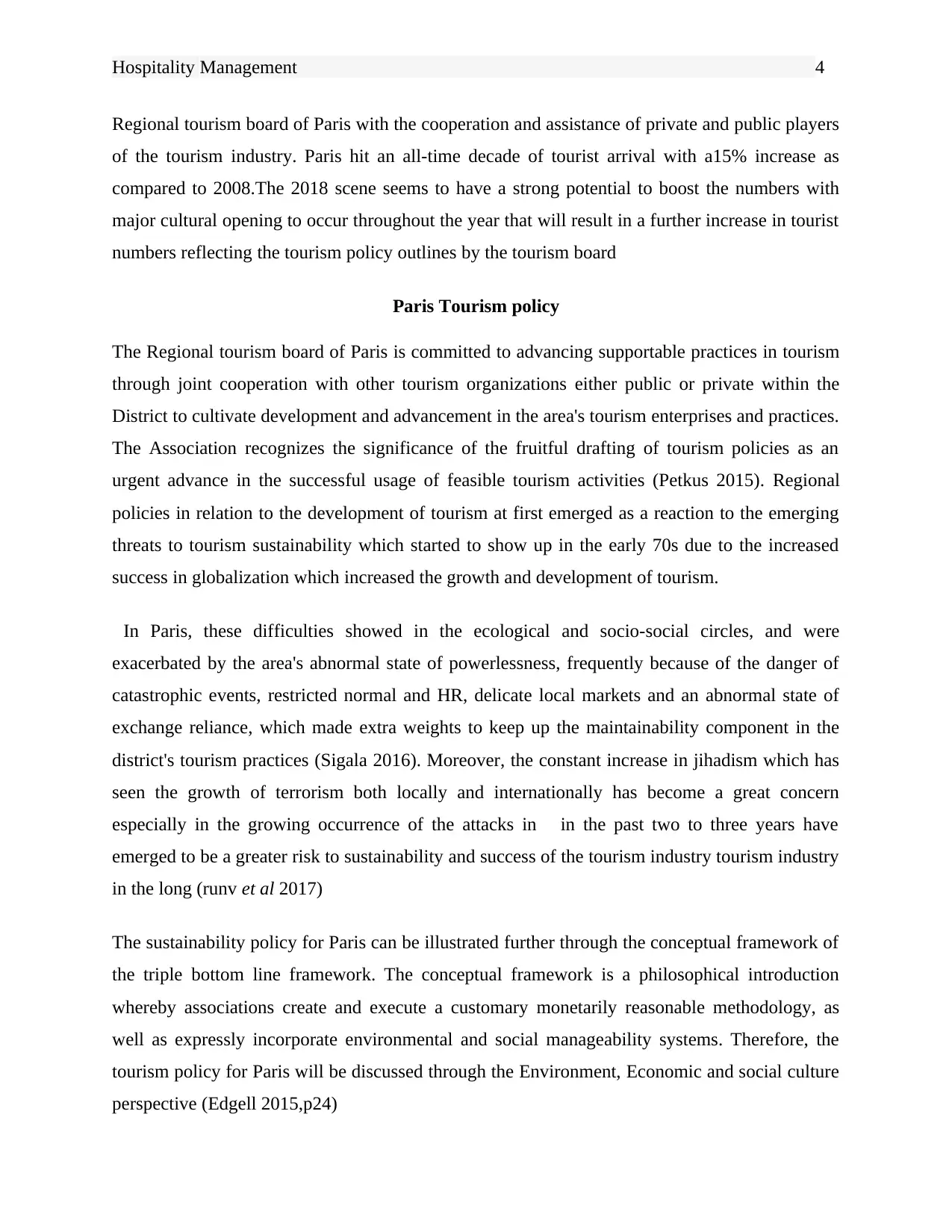
Hospitality Management 4
Regional tourism board of Paris with the cooperation and assistance of private and public players
of the tourism industry. Paris hit an all-time decade of tourist arrival with a15% increase as
compared to 2008.The 2018 scene seems to have a strong potential to boost the numbers with
major cultural opening to occur throughout the year that will result in a further increase in tourist
numbers reflecting the tourism policy outlines by the tourism board
Paris Tourism policy
The Regional tourism board of Paris is committed to advancing supportable practices in tourism
through joint cooperation with other tourism organizations either public or private within the
District to cultivate development and advancement in the area's tourism enterprises and practices.
The Association recognizes the significance of the fruitful drafting of tourism policies as an
urgent advance in the successful usage of feasible tourism activities (Petkus 2015). Regional
policies in relation to the development of tourism at first emerged as a reaction to the emerging
threats to tourism sustainability which started to show up in the early 70s due to the increased
success in globalization which increased the growth and development of tourism.
In Paris, these difficulties showed in the ecological and socio-social circles, and were
exacerbated by the area's abnormal state of powerlessness, frequently because of the danger of
catastrophic events, restricted normal and HR, delicate local markets and an abnormal state of
exchange reliance, which made extra weights to keep up the maintainability component in the
district's tourism practices (Sigala 2016). Moreover, the constant increase in jihadism which has
seen the growth of terrorism both locally and internationally has become a great concern
especially in the growing occurrence of the attacks in in the past two to three years have
emerged to be a greater risk to sustainability and success of the tourism industry tourism industry
in the long (runv et al 2017)
The sustainability policy for Paris can be illustrated further through the conceptual framework of
the triple bottom line framework. The conceptual framework is a philosophical introduction
whereby associations create and execute a customary monetarily reasonable methodology, as
well as expressly incorporate environmental and social manageability systems. Therefore, the
tourism policy for Paris will be discussed through the Environment, Economic and social culture
perspective (Edgell 2015,p24)
Regional tourism board of Paris with the cooperation and assistance of private and public players
of the tourism industry. Paris hit an all-time decade of tourist arrival with a15% increase as
compared to 2008.The 2018 scene seems to have a strong potential to boost the numbers with
major cultural opening to occur throughout the year that will result in a further increase in tourist
numbers reflecting the tourism policy outlines by the tourism board
Paris Tourism policy
The Regional tourism board of Paris is committed to advancing supportable practices in tourism
through joint cooperation with other tourism organizations either public or private within the
District to cultivate development and advancement in the area's tourism enterprises and practices.
The Association recognizes the significance of the fruitful drafting of tourism policies as an
urgent advance in the successful usage of feasible tourism activities (Petkus 2015). Regional
policies in relation to the development of tourism at first emerged as a reaction to the emerging
threats to tourism sustainability which started to show up in the early 70s due to the increased
success in globalization which increased the growth and development of tourism.
In Paris, these difficulties showed in the ecological and socio-social circles, and were
exacerbated by the area's abnormal state of powerlessness, frequently because of the danger of
catastrophic events, restricted normal and HR, delicate local markets and an abnormal state of
exchange reliance, which made extra weights to keep up the maintainability component in the
district's tourism practices (Sigala 2016). Moreover, the constant increase in jihadism which has
seen the growth of terrorism both locally and internationally has become a great concern
especially in the growing occurrence of the attacks in in the past two to three years have
emerged to be a greater risk to sustainability and success of the tourism industry tourism industry
in the long (runv et al 2017)
The sustainability policy for Paris can be illustrated further through the conceptual framework of
the triple bottom line framework. The conceptual framework is a philosophical introduction
whereby associations create and execute a customary monetarily reasonable methodology, as
well as expressly incorporate environmental and social manageability systems. Therefore, the
tourism policy for Paris will be discussed through the Environment, Economic and social culture
perspective (Edgell 2015,p24)
Secure Best Marks with AI Grader
Need help grading? Try our AI Grader for instant feedback on your assignments.

Hospitality Management 5
1.Enviroment
Successful ad sustainable tourism must be accompanied with a keen interest to the conservation
and nurturing of the environment. This means regardless of the need of infrastructure
development it should not be at the expense of the environment (McCleod et al 2018). The issues
related to the environment generally include air and water pollution, waste and ecosystem
management, protections of natural resources, wildlife conservation and finally biodiversity
maintenance. the regional and national government had already put in place measures that would
ensure a sustainable environment and organized infrastructure development (Álvarez et al 2017).
This has made it easier for the Regional tourism board of Paris to develop and implement
policies in relation to this context. Moreover, international organizations that are focused on
environmental prosperity have issued standard and regulations that have to be met regardless of
the industry in a region. For example, when a company wants to construct hotel the relevant
authorities in the regions will assess if any damaged will be caused to the environment such as
destruction of biodiversity habitat (Wilson 2015,p445). The main objective is to has a sustainable
tourism which will have a low impact on the environments and as well benefits the environment
in the long run .some of the objectives of the strategy policies in relation to the environment
include
i. To Show responsive and decisive deliver to capable asset utilize, ecological preservation,
social issues, financial speculation, wellbeing and security and quality issues
ii. Confirmation of appropriate correspondence, interpretation/execution of strategies
vigorously
iii. Confirmation of an Environmental Management System suitable to nature, scale and
extent of the business, and current Environmental Management Plan with clearness and
specificity of plan (objectives, targets, and so forth.) and execution (portion of duty, clear
time allotments and so forth.)
1.Enviroment
Successful ad sustainable tourism must be accompanied with a keen interest to the conservation
and nurturing of the environment. This means regardless of the need of infrastructure
development it should not be at the expense of the environment (McCleod et al 2018). The issues
related to the environment generally include air and water pollution, waste and ecosystem
management, protections of natural resources, wildlife conservation and finally biodiversity
maintenance. the regional and national government had already put in place measures that would
ensure a sustainable environment and organized infrastructure development (Álvarez et al 2017).
This has made it easier for the Regional tourism board of Paris to develop and implement
policies in relation to this context. Moreover, international organizations that are focused on
environmental prosperity have issued standard and regulations that have to be met regardless of
the industry in a region. For example, when a company wants to construct hotel the relevant
authorities in the regions will assess if any damaged will be caused to the environment such as
destruction of biodiversity habitat (Wilson 2015,p445). The main objective is to has a sustainable
tourism which will have a low impact on the environments and as well benefits the environment
in the long run .some of the objectives of the strategy policies in relation to the environment
include
i. To Show responsive and decisive deliver to capable asset utilize, ecological preservation,
social issues, financial speculation, wellbeing and security and quality issues
ii. Confirmation of appropriate correspondence, interpretation/execution of strategies
vigorously
iii. Confirmation of an Environmental Management System suitable to nature, scale and
extent of the business, and current Environmental Management Plan with clearness and
specificity of plan (objectives, targets, and so forth.) and execution (portion of duty, clear
time allotments and so forth.)
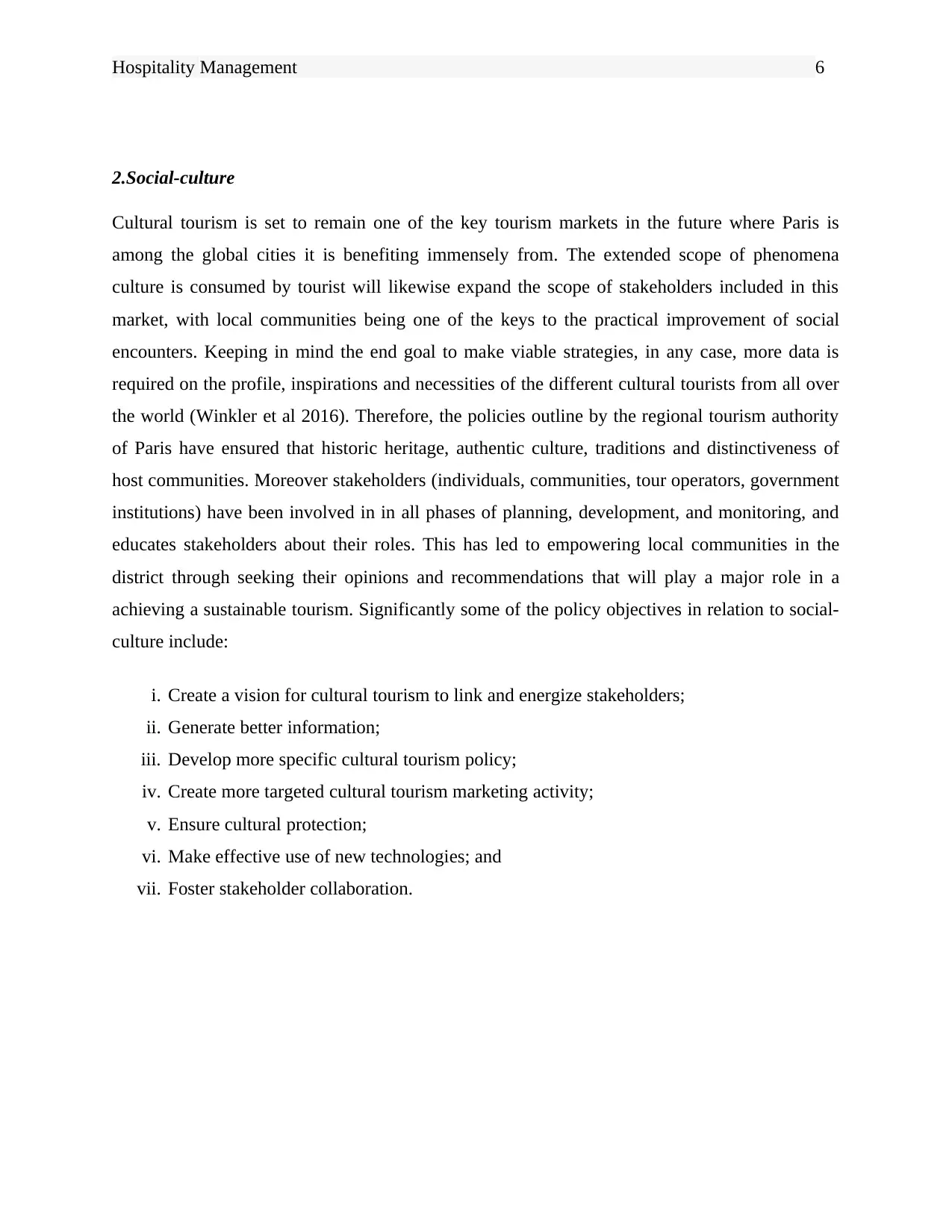
Hospitality Management 6
2.Social-culture
Cultural tourism is set to remain one of the key tourism markets in the future where Paris is
among the global cities it is benefiting immensely from. The extended scope of phenomena
culture is consumed by tourist will likewise expand the scope of stakeholders included in this
market, with local communities being one of the keys to the practical improvement of social
encounters. Keeping in mind the end goal to make viable strategies, in any case, more data is
required on the profile, inspirations and necessities of the different cultural tourists from all over
the world (Winkler et al 2016). Therefore, the policies outline by the regional tourism authority
of Paris have ensured that historic heritage, authentic culture, traditions and distinctiveness of
host communities. Moreover stakeholders (individuals, communities, tour operators, government
institutions) have been involved in in all phases of planning, development, and monitoring, and
educates stakeholders about their roles. This has led to empowering local communities in the
district through seeking their opinions and recommendations that will play a major role in a
achieving a sustainable tourism. Significantly some of the policy objectives in relation to social-
culture include:
i. Create a vision for cultural tourism to link and energize stakeholders;
ii. Generate better information;
iii. Develop more specific cultural tourism policy;
iv. Create more targeted cultural tourism marketing activity;
v. Ensure cultural protection;
vi. Make effective use of new technologies; and
vii. Foster stakeholder collaboration.
2.Social-culture
Cultural tourism is set to remain one of the key tourism markets in the future where Paris is
among the global cities it is benefiting immensely from. The extended scope of phenomena
culture is consumed by tourist will likewise expand the scope of stakeholders included in this
market, with local communities being one of the keys to the practical improvement of social
encounters. Keeping in mind the end goal to make viable strategies, in any case, more data is
required on the profile, inspirations and necessities of the different cultural tourists from all over
the world (Winkler et al 2016). Therefore, the policies outline by the regional tourism authority
of Paris have ensured that historic heritage, authentic culture, traditions and distinctiveness of
host communities. Moreover stakeholders (individuals, communities, tour operators, government
institutions) have been involved in in all phases of planning, development, and monitoring, and
educates stakeholders about their roles. This has led to empowering local communities in the
district through seeking their opinions and recommendations that will play a major role in a
achieving a sustainable tourism. Significantly some of the policy objectives in relation to social-
culture include:
i. Create a vision for cultural tourism to link and energize stakeholders;
ii. Generate better information;
iii. Develop more specific cultural tourism policy;
iv. Create more targeted cultural tourism marketing activity;
v. Ensure cultural protection;
vi. Make effective use of new technologies; and
vii. Foster stakeholder collaboration.
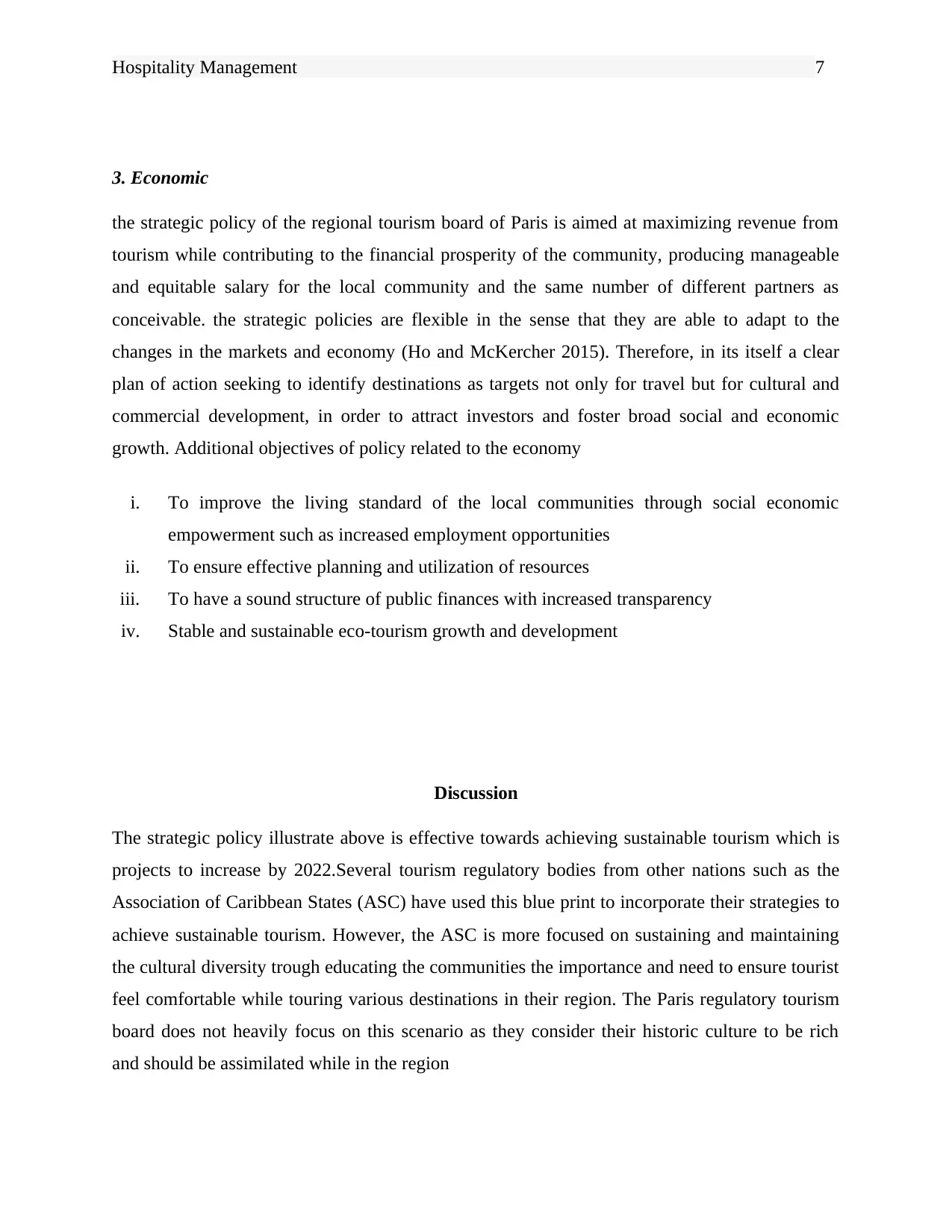
Hospitality Management 7
3. Economic
the strategic policy of the regional tourism board of Paris is aimed at maximizing revenue from
tourism while contributing to the financial prosperity of the community, producing manageable
and equitable salary for the local community and the same number of different partners as
conceivable. the strategic policies are flexible in the sense that they are able to adapt to the
changes in the markets and economy (Ho and McKercher 2015). Therefore, in its itself a clear
plan of action seeking to identify destinations as targets not only for travel but for cultural and
commercial development, in order to attract investors and foster broad social and economic
growth. Additional objectives of policy related to the economy
i. To improve the living standard of the local communities through social economic
empowerment such as increased employment opportunities
ii. To ensure effective planning and utilization of resources
iii. To have a sound structure of public finances with increased transparency
iv. Stable and sustainable eco-tourism growth and development
Discussion
The strategic policy illustrate above is effective towards achieving sustainable tourism which is
projects to increase by 2022.Several tourism regulatory bodies from other nations such as the
Association of Caribbean States (ASC) have used this blue print to incorporate their strategies to
achieve sustainable tourism. However, the ASC is more focused on sustaining and maintaining
the cultural diversity trough educating the communities the importance and need to ensure tourist
feel comfortable while touring various destinations in their region. The Paris regulatory tourism
board does not heavily focus on this scenario as they consider their historic culture to be rich
and should be assimilated while in the region
3. Economic
the strategic policy of the regional tourism board of Paris is aimed at maximizing revenue from
tourism while contributing to the financial prosperity of the community, producing manageable
and equitable salary for the local community and the same number of different partners as
conceivable. the strategic policies are flexible in the sense that they are able to adapt to the
changes in the markets and economy (Ho and McKercher 2015). Therefore, in its itself a clear
plan of action seeking to identify destinations as targets not only for travel but for cultural and
commercial development, in order to attract investors and foster broad social and economic
growth. Additional objectives of policy related to the economy
i. To improve the living standard of the local communities through social economic
empowerment such as increased employment opportunities
ii. To ensure effective planning and utilization of resources
iii. To have a sound structure of public finances with increased transparency
iv. Stable and sustainable eco-tourism growth and development
Discussion
The strategic policy illustrate above is effective towards achieving sustainable tourism which is
projects to increase by 2022.Several tourism regulatory bodies from other nations such as the
Association of Caribbean States (ASC) have used this blue print to incorporate their strategies to
achieve sustainable tourism. However, the ASC is more focused on sustaining and maintaining
the cultural diversity trough educating the communities the importance and need to ensure tourist
feel comfortable while touring various destinations in their region. The Paris regulatory tourism
board does not heavily focus on this scenario as they consider their historic culture to be rich
and should be assimilated while in the region
Paraphrase This Document
Need a fresh take? Get an instant paraphrase of this document with our AI Paraphraser

Hospitality Management 8
Butler S Lifecycle Model
The butlers Lifecycle model has several stages essential in breaking down and capturing the
maximum tourist levels in Paris and spearhead efficient decision making and policy
implementation. The Butler model core purpose is to critically analyze the growth and
development of the tourist resorts in a certain location. It’s essential in determining the
maximum number of tourists during a given time. Moreover, it is also used to determine the
impact that a specific location has on tourist. This allows the tourism regulation bodies to
identify if there is any need of improvement in the locations o as to maximize profits and
increase more visitors. The tourism industry is just like any other industry which is complex in
its own ways. Therefore, the model has tabulated the several stages essential in determining the
maximum level of tourist numbers achievable (Gross 2015, p 70).
Butler S Lifecycle Model
The butlers Lifecycle model has several stages essential in breaking down and capturing the
maximum tourist levels in Paris and spearhead efficient decision making and policy
implementation. The Butler model core purpose is to critically analyze the growth and
development of the tourist resorts in a certain location. It’s essential in determining the
maximum number of tourists during a given time. Moreover, it is also used to determine the
impact that a specific location has on tourist. This allows the tourism regulation bodies to
identify if there is any need of improvement in the locations o as to maximize profits and
increase more visitors. The tourism industry is just like any other industry which is complex in
its own ways. Therefore, the model has tabulated the several stages essential in determining the
maximum level of tourist numbers achievable (Gross 2015, p 70).
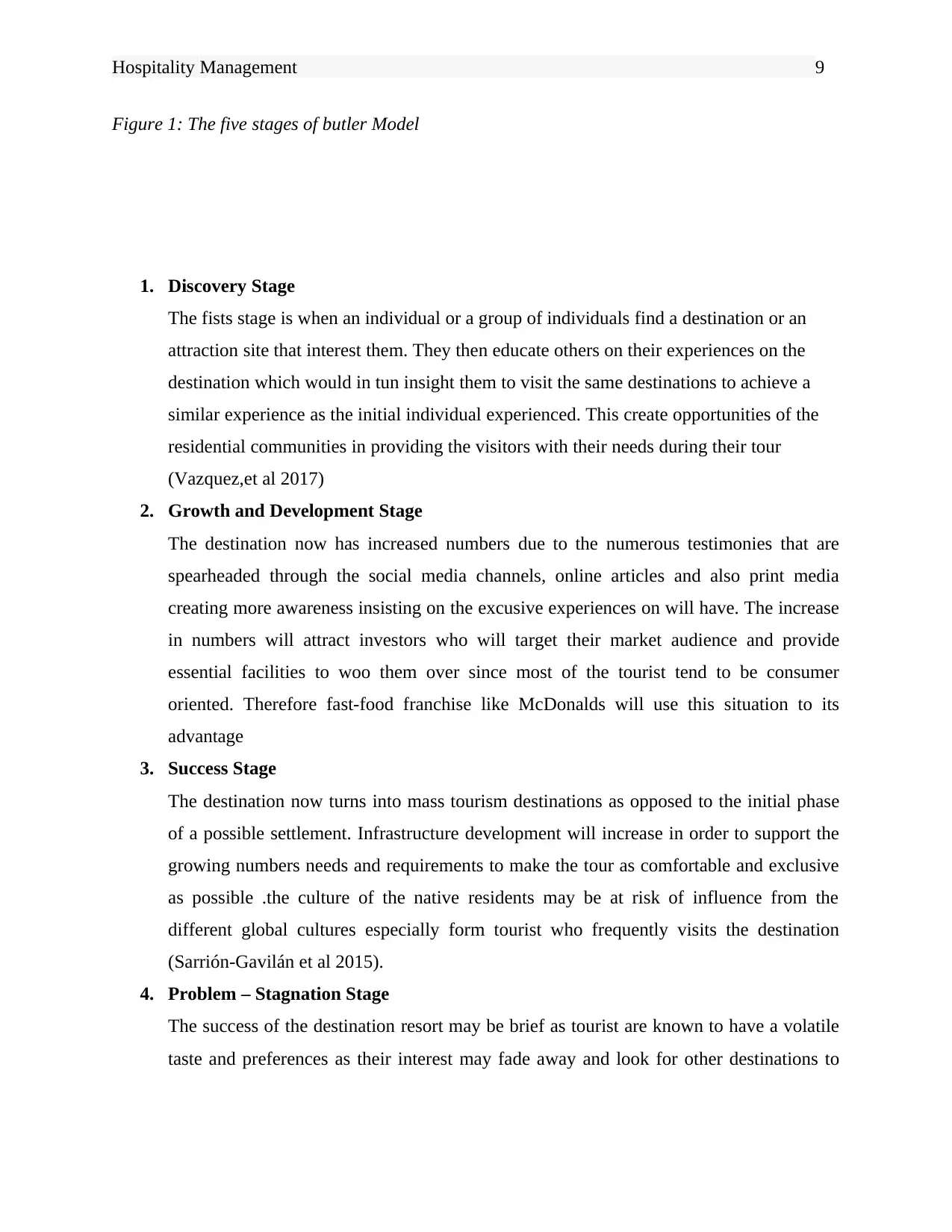
Hospitality Management 9
Figure 1: The five stages of butler Model
1. Discovery Stage
The fists stage is when an individual or a group of individuals find a destination or an
attraction site that interest them. They then educate others on their experiences on the
destination which would in tun insight them to visit the same destinations to achieve a
similar experience as the initial individual experienced. This create opportunities of the
residential communities in providing the visitors with their needs during their tour
(Vazquez,et al 2017)
2. Growth and Development Stage
The destination now has increased numbers due to the numerous testimonies that are
spearheaded through the social media channels, online articles and also print media
creating more awareness insisting on the excusive experiences on will have. The increase
in numbers will attract investors who will target their market audience and provide
essential facilities to woo them over since most of the tourist tend to be consumer
oriented. Therefore fast-food franchise like McDonalds will use this situation to its
advantage
3. Success Stage
The destination now turns into mass tourism destinations as opposed to the initial phase
of a possible settlement. Infrastructure development will increase in order to support the
growing numbers needs and requirements to make the tour as comfortable and exclusive
as possible .the culture of the native residents may be at risk of influence from the
different global cultures especially form tourist who frequently visits the destination
(Sarrión-Gavilán et al 2015).
4. Problem – Stagnation Stage
The success of the destination resort may be brief as tourist are known to have a volatile
taste and preferences as their interest may fade away and look for other destinations to
Figure 1: The five stages of butler Model
1. Discovery Stage
The fists stage is when an individual or a group of individuals find a destination or an
attraction site that interest them. They then educate others on their experiences on the
destination which would in tun insight them to visit the same destinations to achieve a
similar experience as the initial individual experienced. This create opportunities of the
residential communities in providing the visitors with their needs during their tour
(Vazquez,et al 2017)
2. Growth and Development Stage
The destination now has increased numbers due to the numerous testimonies that are
spearheaded through the social media channels, online articles and also print media
creating more awareness insisting on the excusive experiences on will have. The increase
in numbers will attract investors who will target their market audience and provide
essential facilities to woo them over since most of the tourist tend to be consumer
oriented. Therefore fast-food franchise like McDonalds will use this situation to its
advantage
3. Success Stage
The destination now turns into mass tourism destinations as opposed to the initial phase
of a possible settlement. Infrastructure development will increase in order to support the
growing numbers needs and requirements to make the tour as comfortable and exclusive
as possible .the culture of the native residents may be at risk of influence from the
different global cultures especially form tourist who frequently visits the destination
(Sarrión-Gavilán et al 2015).
4. Problem – Stagnation Stage
The success of the destination resort may be brief as tourist are known to have a volatile
taste and preferences as their interest may fade away and look for other destinations to

Hospitality Management 10
travel. This will result in increased losses as the numbers reduced significantly futher
affecting the destination (Pulido-Fernándezet al 2015,p57)
5. Decline or Rejuvenation
The last result is to make and analysis and determine if the destination can be refurbished
or Identifying ways that can increase and maintain the tourist numbers through strategic
investment. However, if all options on the table or solutions do not seem to solve the
situation, the destination has a high risk of abandonment
Recommendation: Agenda 21
The current tourism policy incorporated in Paris is so far sufficient in meeting its current goals
and objective however it still can be fine-tuned through the use of the Agenda 21 which is and
agreements among 150 nations towards sustainable development. These nations agreed to
develop their own local agenda 21 to critically meet the goals and objectives that had been set. In
France, Local Agenda 21 is a deliberate procedure, molded by the will of the mayor or the
president and that is can clarify the postponement for reception of local Agenda 21. However,
the governs has supported all agencies and in the regional levels in developing and implementing
their local agenda 21 in regard to their respective industry. Therefore, the regional tourism board
of Paris should develop its local agenda 21 that will complement its policies towards achieving
sustainable tourism in Paris. Below are the strategic guidelines of the development of local
agenda 21 in relation to the tourism and hospitality industry in Paris (Dahl 2014). The
development of sustainable tourism in Paris should meet the following requirements:
i. Tourist resources - natural, historical, social and others - are safeguarded in a way that
enables them to be utilized later on, while profiting the present society;
ii. The planning and administration of the development of tourist are led in a way that
maintains a strategic distance from activating genuine biological or socio-social issues in
the district concerned i.e. Paris
iii. The general environmental quality in the tourist destination is protected and, if vital,
should be improved;
travel. This will result in increased losses as the numbers reduced significantly futher
affecting the destination (Pulido-Fernándezet al 2015,p57)
5. Decline or Rejuvenation
The last result is to make and analysis and determine if the destination can be refurbished
or Identifying ways that can increase and maintain the tourist numbers through strategic
investment. However, if all options on the table or solutions do not seem to solve the
situation, the destination has a high risk of abandonment
Recommendation: Agenda 21
The current tourism policy incorporated in Paris is so far sufficient in meeting its current goals
and objective however it still can be fine-tuned through the use of the Agenda 21 which is and
agreements among 150 nations towards sustainable development. These nations agreed to
develop their own local agenda 21 to critically meet the goals and objectives that had been set. In
France, Local Agenda 21 is a deliberate procedure, molded by the will of the mayor or the
president and that is can clarify the postponement for reception of local Agenda 21. However,
the governs has supported all agencies and in the regional levels in developing and implementing
their local agenda 21 in regard to their respective industry. Therefore, the regional tourism board
of Paris should develop its local agenda 21 that will complement its policies towards achieving
sustainable tourism in Paris. Below are the strategic guidelines of the development of local
agenda 21 in relation to the tourism and hospitality industry in Paris (Dahl 2014). The
development of sustainable tourism in Paris should meet the following requirements:
i. Tourist resources - natural, historical, social and others - are safeguarded in a way that
enables them to be utilized later on, while profiting the present society;
ii. The planning and administration of the development of tourist are led in a way that
maintains a strategic distance from activating genuine biological or socio-social issues in
the district concerned i.e. Paris
iii. The general environmental quality in the tourist destination is protected and, if vital,
should be improved;
Secure Best Marks with AI Grader
Need help grading? Try our AI Grader for instant feedback on your assignments.

Hospitality Management 11
iv. The level of tourist satisfaction ought to be kept up to guarantee that goals proceed to be
appealing and hold their business potential; and tourism ought to a great extent advantage
all individuals from society
Conclusion
Tourism is one of the major industries that have been on the ascent since the information age
essentially because of the increased innovation which has assumed a noteworthy part in effective
globalization and successful contribution to the economy globally. This paper has chosen Paris
as its significant tourist destination which is controlled and managed by the regional tourism
board of Paris. Its importance to France in contributing to the GDP and as well as impacting
positively the local communities in Paris had bee illustrated in the paper. Moreover, the various
strategic policies developed by the board ahs been discussed through an economic,
environmental and social cultural perceptive. So far so good as the objectives of the polices seem
to be heading in the right direction, however a mild comparison with the Association of
Caribbean States (ASC) which is more focused on sustaining and maintaining the cultural
diversity trough educating the communities the importance and need to ensure tourist feel
comfortable while touring various destinations in their region. The Paris regulatory tourism
board does not heavily focus on this scenario as they consider their historic culture to be rich
and should be assimilated while in the region. Finally recommendations have been illustrated in
the paper through the use of Butler S Lifecycle Model and the use the Agenda 21 which will
increase the focus on sustainable tourism in the long run.
iv. The level of tourist satisfaction ought to be kept up to guarantee that goals proceed to be
appealing and hold their business potential; and tourism ought to a great extent advantage
all individuals from society
Conclusion
Tourism is one of the major industries that have been on the ascent since the information age
essentially because of the increased innovation which has assumed a noteworthy part in effective
globalization and successful contribution to the economy globally. This paper has chosen Paris
as its significant tourist destination which is controlled and managed by the regional tourism
board of Paris. Its importance to France in contributing to the GDP and as well as impacting
positively the local communities in Paris had bee illustrated in the paper. Moreover, the various
strategic policies developed by the board ahs been discussed through an economic,
environmental and social cultural perceptive. So far so good as the objectives of the polices seem
to be heading in the right direction, however a mild comparison with the Association of
Caribbean States (ASC) which is more focused on sustaining and maintaining the cultural
diversity trough educating the communities the importance and need to ensure tourist feel
comfortable while touring various destinations in their region. The Paris regulatory tourism
board does not heavily focus on this scenario as they consider their historic culture to be rich
and should be assimilated while in the region. Finally recommendations have been illustrated in
the paper through the use of Butler S Lifecycle Model and the use the Agenda 21 which will
increase the focus on sustainable tourism in the long run.
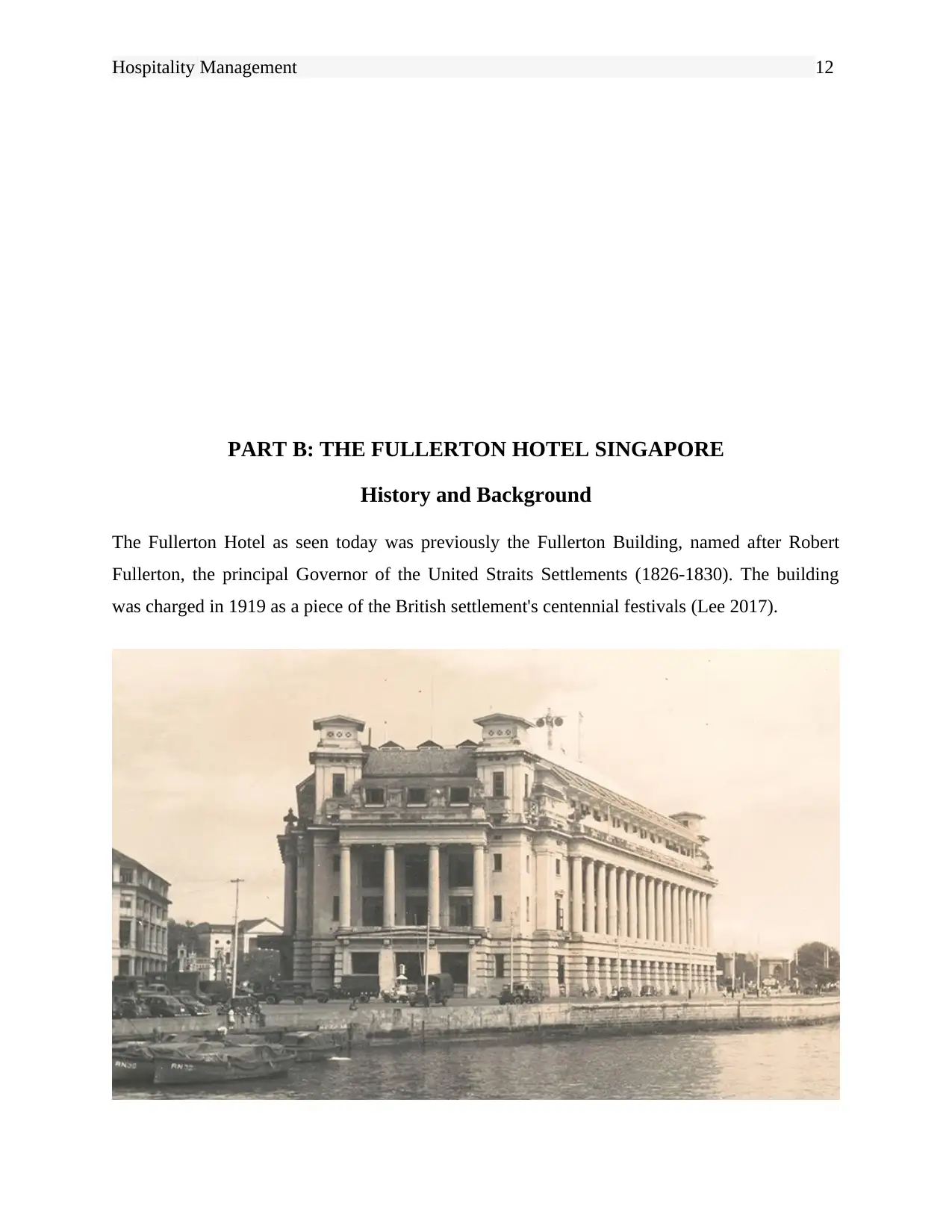
Hospitality Management 12
PART B: THE FULLERTON HOTEL SINGAPORE
History and Background
The Fullerton Hotel as seen today was previously the Fullerton Building, named after Robert
Fullerton, the principal Governor of the United Straits Settlements (1826-1830). The building
was charged in 1919 as a piece of the British settlement's centennial festivals (Lee 2017).
PART B: THE FULLERTON HOTEL SINGAPORE
History and Background
The Fullerton Hotel as seen today was previously the Fullerton Building, named after Robert
Fullerton, the principal Governor of the United Straits Settlements (1826-1830). The building
was charged in 1919 as a piece of the British settlement's centennial festivals (Lee 2017).
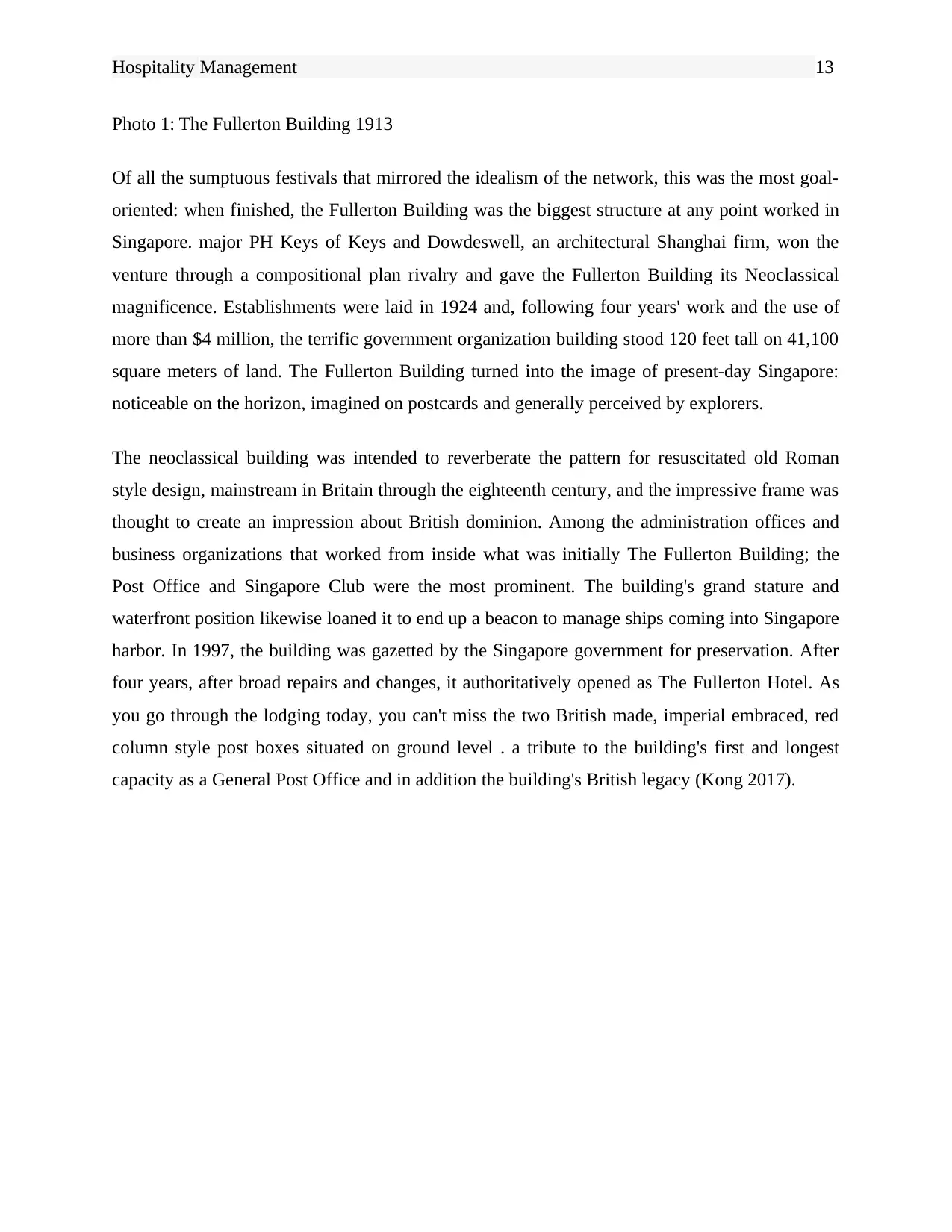
Hospitality Management 13
Photo 1: The Fullerton Building 1913
Of all the sumptuous festivals that mirrored the idealism of the network, this was the most goal-
oriented: when finished, the Fullerton Building was the biggest structure at any point worked in
Singapore. major PH Keys of Keys and Dowdeswell, an architectural Shanghai firm, won the
venture through a compositional plan rivalry and gave the Fullerton Building its Neoclassical
magnificence. Establishments were laid in 1924 and, following four years' work and the use of
more than $4 million, the terrific government organization building stood 120 feet tall on 41,100
square meters of land. The Fullerton Building turned into the image of present-day Singapore:
noticeable on the horizon, imagined on postcards and generally perceived by explorers.
The neoclassical building was intended to reverberate the pattern for resuscitated old Roman
style design, mainstream in Britain through the eighteenth century, and the impressive frame was
thought to create an impression about British dominion. Among the administration offices and
business organizations that worked from inside what was initially The Fullerton Building; the
Post Office and Singapore Club were the most prominent. The building's grand stature and
waterfront position likewise loaned it to end up a beacon to manage ships coming into Singapore
harbor. In 1997, the building was gazetted by the Singapore government for preservation. After
four years, after broad repairs and changes, it authoritatively opened as The Fullerton Hotel. As
you go through the lodging today, you can't miss the two British made, imperial embraced, red
column style post boxes situated on ground level . a tribute to the building's first and longest
capacity as a General Post Office and in addition the building's British legacy (Kong 2017).
Photo 1: The Fullerton Building 1913
Of all the sumptuous festivals that mirrored the idealism of the network, this was the most goal-
oriented: when finished, the Fullerton Building was the biggest structure at any point worked in
Singapore. major PH Keys of Keys and Dowdeswell, an architectural Shanghai firm, won the
venture through a compositional plan rivalry and gave the Fullerton Building its Neoclassical
magnificence. Establishments were laid in 1924 and, following four years' work and the use of
more than $4 million, the terrific government organization building stood 120 feet tall on 41,100
square meters of land. The Fullerton Building turned into the image of present-day Singapore:
noticeable on the horizon, imagined on postcards and generally perceived by explorers.
The neoclassical building was intended to reverberate the pattern for resuscitated old Roman
style design, mainstream in Britain through the eighteenth century, and the impressive frame was
thought to create an impression about British dominion. Among the administration offices and
business organizations that worked from inside what was initially The Fullerton Building; the
Post Office and Singapore Club were the most prominent. The building's grand stature and
waterfront position likewise loaned it to end up a beacon to manage ships coming into Singapore
harbor. In 1997, the building was gazetted by the Singapore government for preservation. After
four years, after broad repairs and changes, it authoritatively opened as The Fullerton Hotel. As
you go through the lodging today, you can't miss the two British made, imperial embraced, red
column style post boxes situated on ground level . a tribute to the building's first and longest
capacity as a General Post Office and in addition the building's British legacy (Kong 2017).
Paraphrase This Document
Need a fresh take? Get an instant paraphrase of this document with our AI Paraphraser

Hospitality Management 14
Photo 2: $400 million dollar ongoing renovation in 1998
In January 2001, the Fullerton Building was renewed as the six-star Fullerton Hotel. The test was
to mix the eminence and respect of the first structure with the extravagance and richness required
by its new symbol. Broad redesigns were done and about $400 million was spent to change over
the place of business into a 400-room lavish inn. It was determined that the first outsides and
insides be reestablished to their unique condition beyond what many would consider possible
(Guides 2016). The memorable beacon that guided boats into the port was consolidated into a
fine-eating eatery called The Lighthouse. Close to two decades on, the building keeps on
recounting the narrative of Singapore, as it keeps up its all-encompassing perspectives over
Marina Bay, the Singapore River, and the consistently developing cityscape (Hargreaves 2015).
Photo 2: $400 million dollar ongoing renovation in 1998
In January 2001, the Fullerton Building was renewed as the six-star Fullerton Hotel. The test was
to mix the eminence and respect of the first structure with the extravagance and richness required
by its new symbol. Broad redesigns were done and about $400 million was spent to change over
the place of business into a 400-room lavish inn. It was determined that the first outsides and
insides be reestablished to their unique condition beyond what many would consider possible
(Guides 2016). The memorable beacon that guided boats into the port was consolidated into a
fine-eating eatery called The Lighthouse. Close to two decades on, the building keeps on
recounting the narrative of Singapore, as it keeps up its all-encompassing perspectives over
Marina Bay, the Singapore River, and the consistently developing cityscape (Hargreaves 2015).
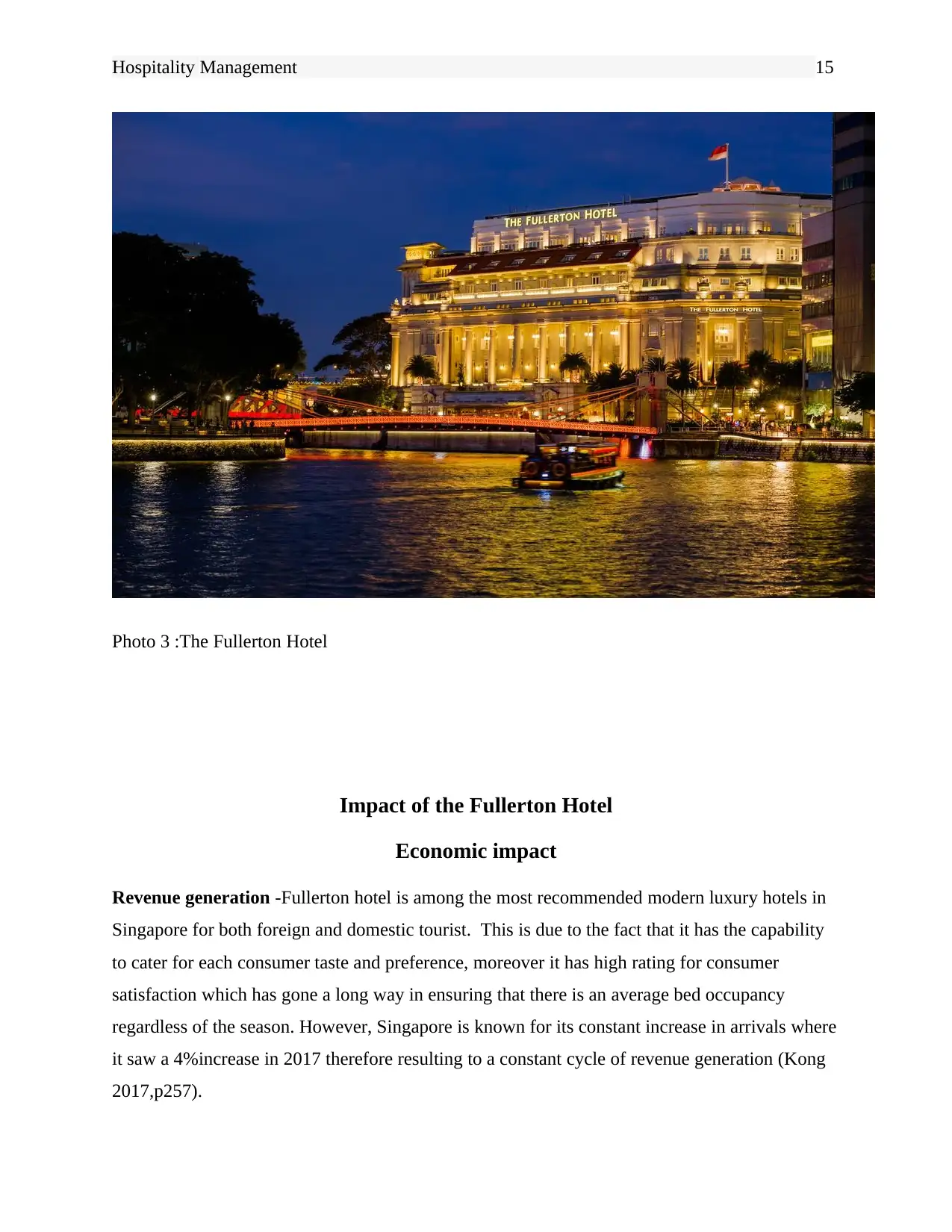
Hospitality Management 15
Photo 3 :The Fullerton Hotel
Impact of the Fullerton Hotel
Economic impact
Revenue generation -Fullerton hotel is among the most recommended modern luxury hotels in
Singapore for both foreign and domestic tourist. This is due to the fact that it has the capability
to cater for each consumer taste and preference, moreover it has high rating for consumer
satisfaction which has gone a long way in ensuring that there is an average bed occupancy
regardless of the season. However, Singapore is known for its constant increase in arrivals where
it saw a 4%increase in 2017 therefore resulting to a constant cycle of revenue generation (Kong
2017,p257).
Photo 3 :The Fullerton Hotel
Impact of the Fullerton Hotel
Economic impact
Revenue generation -Fullerton hotel is among the most recommended modern luxury hotels in
Singapore for both foreign and domestic tourist. This is due to the fact that it has the capability
to cater for each consumer taste and preference, moreover it has high rating for consumer
satisfaction which has gone a long way in ensuring that there is an average bed occupancy
regardless of the season. However, Singapore is known for its constant increase in arrivals where
it saw a 4%increase in 2017 therefore resulting to a constant cycle of revenue generation (Kong
2017,p257).
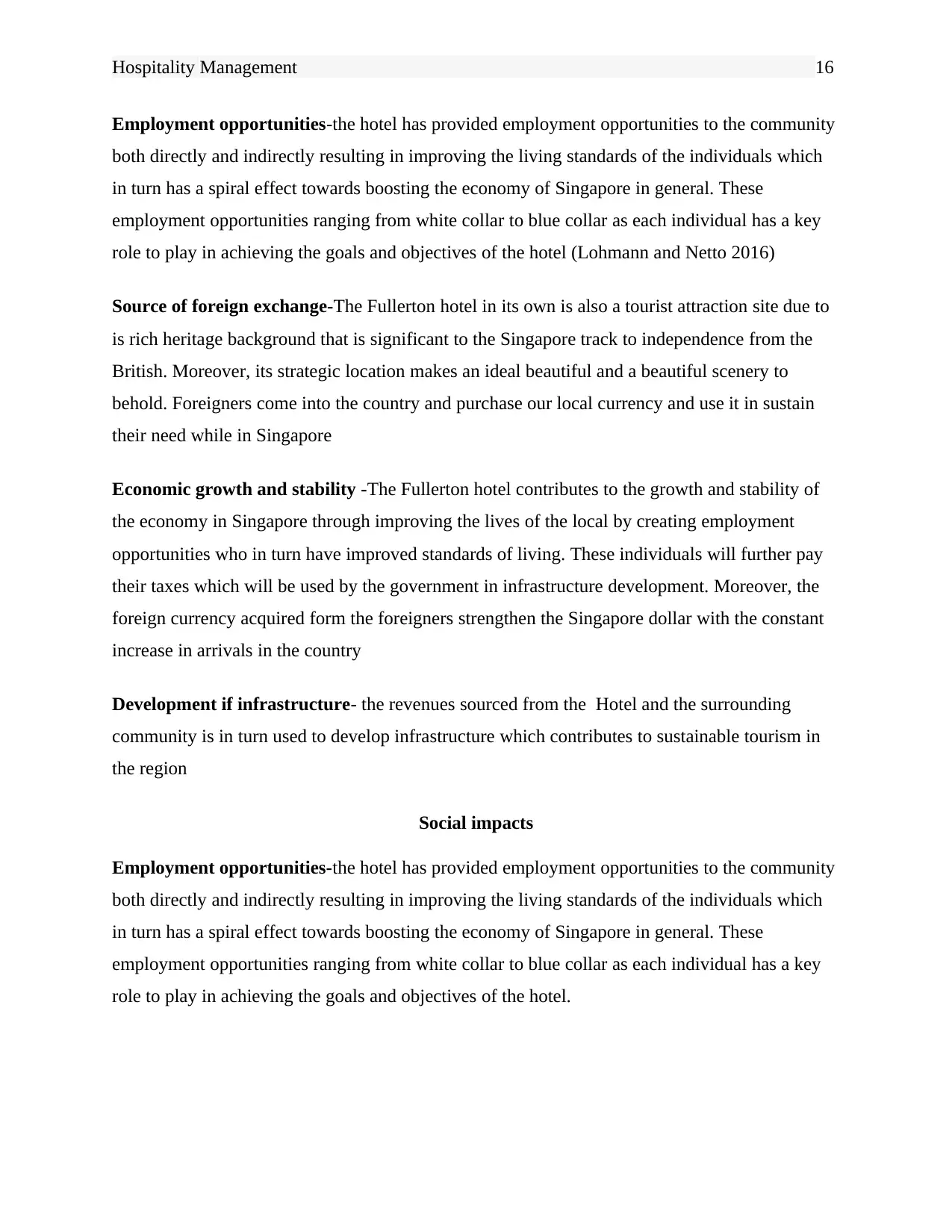
Hospitality Management 16
Employment opportunities-the hotel has provided employment opportunities to the community
both directly and indirectly resulting in improving the living standards of the individuals which
in turn has a spiral effect towards boosting the economy of Singapore in general. These
employment opportunities ranging from white collar to blue collar as each individual has a key
role to play in achieving the goals and objectives of the hotel (Lohmann and Netto 2016)
Source of foreign exchange-The Fullerton hotel in its own is also a tourist attraction site due to
is rich heritage background that is significant to the Singapore track to independence from the
British. Moreover, its strategic location makes an ideal beautiful and a beautiful scenery to
behold. Foreigners come into the country and purchase our local currency and use it in sustain
their need while in Singapore
Economic growth and stability -The Fullerton hotel contributes to the growth and stability of
the economy in Singapore through improving the lives of the local by creating employment
opportunities who in turn have improved standards of living. These individuals will further pay
their taxes which will be used by the government in infrastructure development. Moreover, the
foreign currency acquired form the foreigners strengthen the Singapore dollar with the constant
increase in arrivals in the country
Development if infrastructure- the revenues sourced from the Hotel and the surrounding
community is in turn used to develop infrastructure which contributes to sustainable tourism in
the region
Social impacts
Employment opportunities-the hotel has provided employment opportunities to the community
both directly and indirectly resulting in improving the living standards of the individuals which
in turn has a spiral effect towards boosting the economy of Singapore in general. These
employment opportunities ranging from white collar to blue collar as each individual has a key
role to play in achieving the goals and objectives of the hotel.
Employment opportunities-the hotel has provided employment opportunities to the community
both directly and indirectly resulting in improving the living standards of the individuals which
in turn has a spiral effect towards boosting the economy of Singapore in general. These
employment opportunities ranging from white collar to blue collar as each individual has a key
role to play in achieving the goals and objectives of the hotel (Lohmann and Netto 2016)
Source of foreign exchange-The Fullerton hotel in its own is also a tourist attraction site due to
is rich heritage background that is significant to the Singapore track to independence from the
British. Moreover, its strategic location makes an ideal beautiful and a beautiful scenery to
behold. Foreigners come into the country and purchase our local currency and use it in sustain
their need while in Singapore
Economic growth and stability -The Fullerton hotel contributes to the growth and stability of
the economy in Singapore through improving the lives of the local by creating employment
opportunities who in turn have improved standards of living. These individuals will further pay
their taxes which will be used by the government in infrastructure development. Moreover, the
foreign currency acquired form the foreigners strengthen the Singapore dollar with the constant
increase in arrivals in the country
Development if infrastructure- the revenues sourced from the Hotel and the surrounding
community is in turn used to develop infrastructure which contributes to sustainable tourism in
the region
Social impacts
Employment opportunities-the hotel has provided employment opportunities to the community
both directly and indirectly resulting in improving the living standards of the individuals which
in turn has a spiral effect towards boosting the economy of Singapore in general. These
employment opportunities ranging from white collar to blue collar as each individual has a key
role to play in achieving the goals and objectives of the hotel.
Secure Best Marks with AI Grader
Need help grading? Try our AI Grader for instant feedback on your assignments.
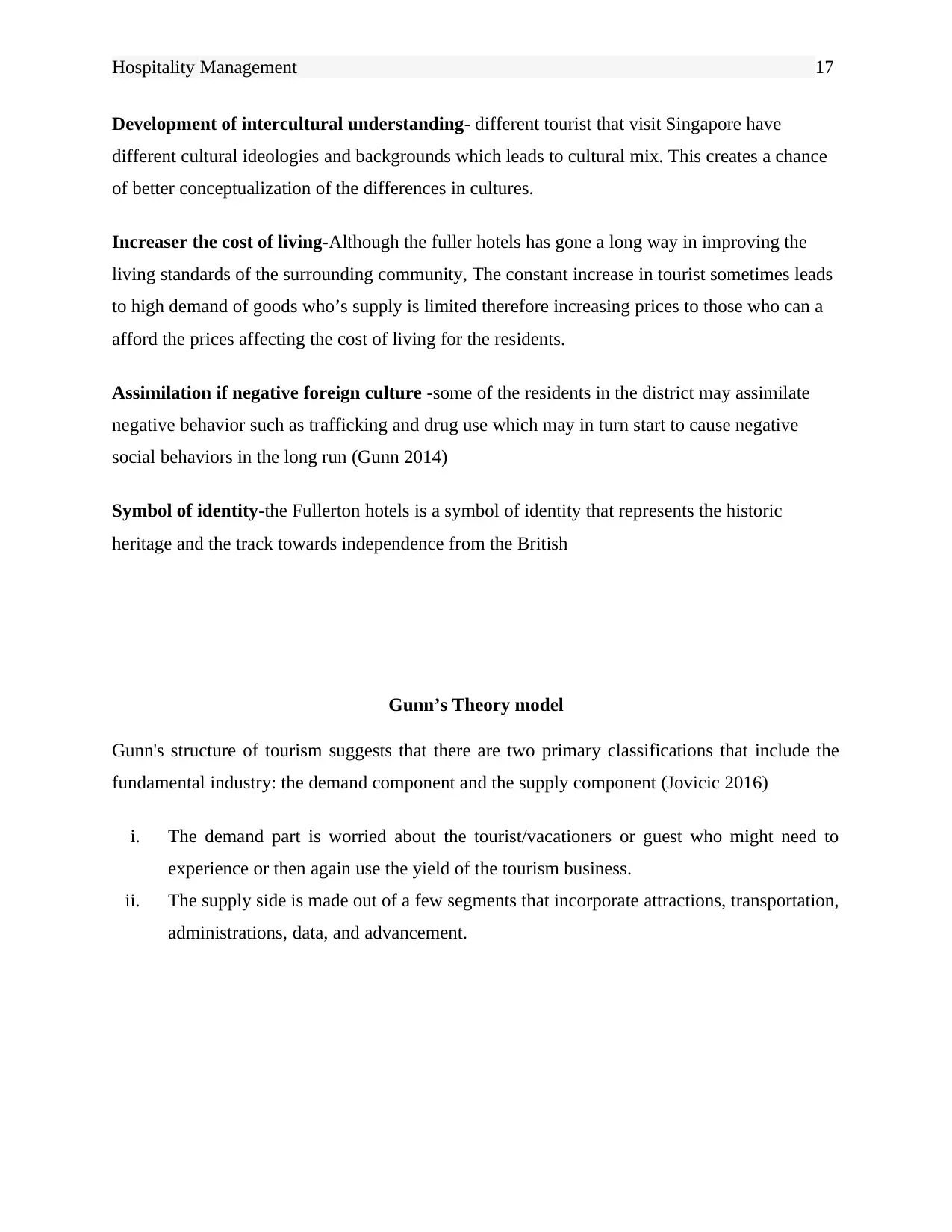
Hospitality Management 17
Development of intercultural understanding- different tourist that visit Singapore have
different cultural ideologies and backgrounds which leads to cultural mix. This creates a chance
of better conceptualization of the differences in cultures.
Increaser the cost of living-Although the fuller hotels has gone a long way in improving the
living standards of the surrounding community, The constant increase in tourist sometimes leads
to high demand of goods who’s supply is limited therefore increasing prices to those who can a
afford the prices affecting the cost of living for the residents.
Assimilation if negative foreign culture -some of the residents in the district may assimilate
negative behavior such as trafficking and drug use which may in turn start to cause negative
social behaviors in the long run (Gunn 2014)
Symbol of identity-the Fullerton hotels is a symbol of identity that represents the historic
heritage and the track towards independence from the British
Gunn’s Theory model
Gunn's structure of tourism suggests that there are two primary classifications that include the
fundamental industry: the demand component and the supply component (Jovicic 2016)
i. The demand part is worried about the tourist/vacationers or guest who might need to
experience or then again use the yield of the tourism business.
ii. The supply side is made out of a few segments that incorporate attractions, transportation,
administrations, data, and advancement.
Development of intercultural understanding- different tourist that visit Singapore have
different cultural ideologies and backgrounds which leads to cultural mix. This creates a chance
of better conceptualization of the differences in cultures.
Increaser the cost of living-Although the fuller hotels has gone a long way in improving the
living standards of the surrounding community, The constant increase in tourist sometimes leads
to high demand of goods who’s supply is limited therefore increasing prices to those who can a
afford the prices affecting the cost of living for the residents.
Assimilation if negative foreign culture -some of the residents in the district may assimilate
negative behavior such as trafficking and drug use which may in turn start to cause negative
social behaviors in the long run (Gunn 2014)
Symbol of identity-the Fullerton hotels is a symbol of identity that represents the historic
heritage and the track towards independence from the British
Gunn’s Theory model
Gunn's structure of tourism suggests that there are two primary classifications that include the
fundamental industry: the demand component and the supply component (Jovicic 2016)
i. The demand part is worried about the tourist/vacationers or guest who might need to
experience or then again use the yield of the tourism business.
ii. The supply side is made out of a few segments that incorporate attractions, transportation,
administrations, data, and advancement.
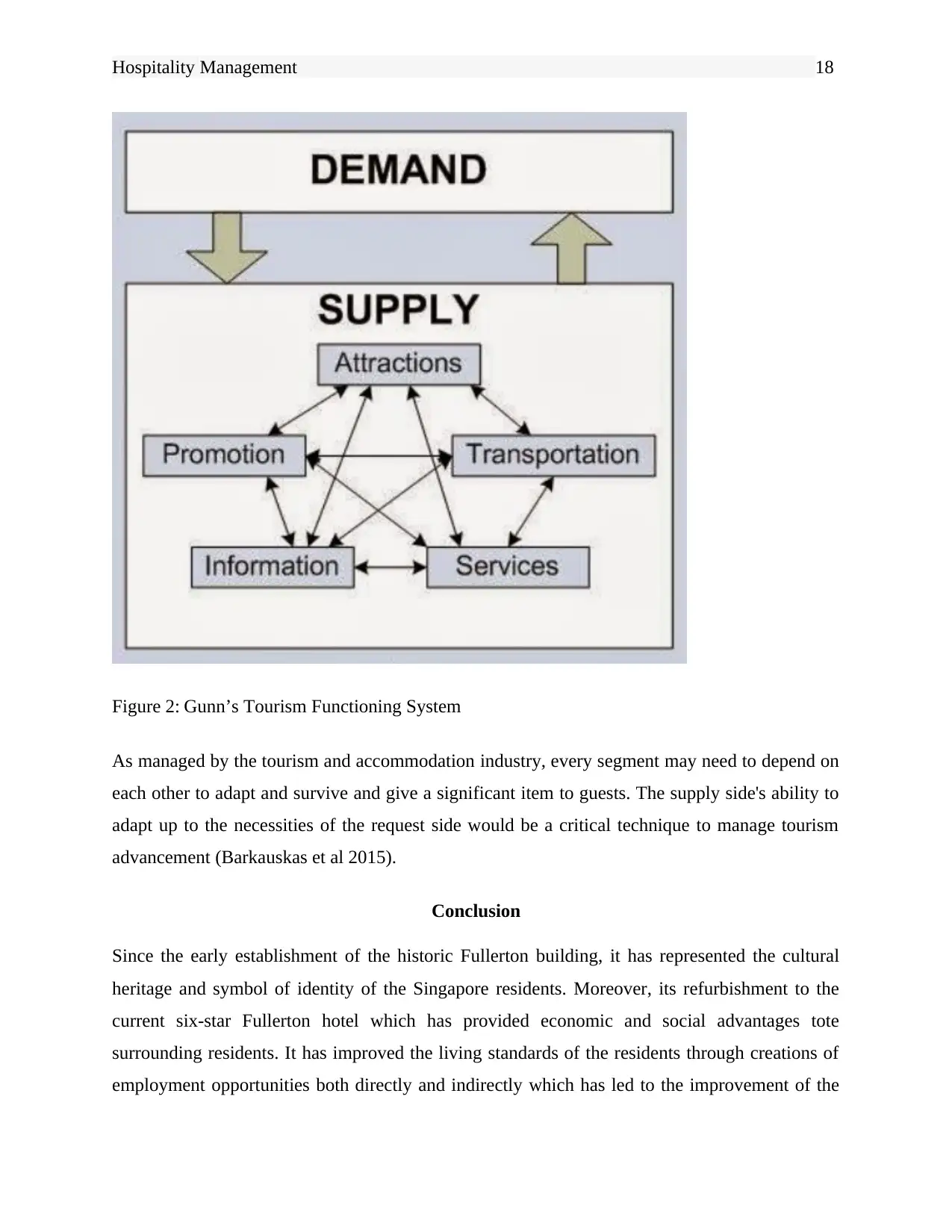
Hospitality Management 18
Figure 2: Gunn’s Tourism Functioning System
As managed by the tourism and accommodation industry, every segment may need to depend on
each other to adapt and survive and give a significant item to guests. The supply side's ability to
adapt up to the necessities of the request side would be a critical technique to manage tourism
advancement (Barkauskas et al 2015).
Conclusion
Since the early establishment of the historic Fullerton building, it has represented the cultural
heritage and symbol of identity of the Singapore residents. Moreover, its refurbishment to the
current six-star Fullerton hotel which has provided economic and social advantages tote
surrounding residents. It has improved the living standards of the residents through creations of
employment opportunities both directly and indirectly which has led to the improvement of the
Figure 2: Gunn’s Tourism Functioning System
As managed by the tourism and accommodation industry, every segment may need to depend on
each other to adapt and survive and give a significant item to guests. The supply side's ability to
adapt up to the necessities of the request side would be a critical technique to manage tourism
advancement (Barkauskas et al 2015).
Conclusion
Since the early establishment of the historic Fullerton building, it has represented the cultural
heritage and symbol of identity of the Singapore residents. Moreover, its refurbishment to the
current six-star Fullerton hotel which has provided economic and social advantages tote
surrounding residents. It has improved the living standards of the residents through creations of
employment opportunities both directly and indirectly which has led to the improvement of the
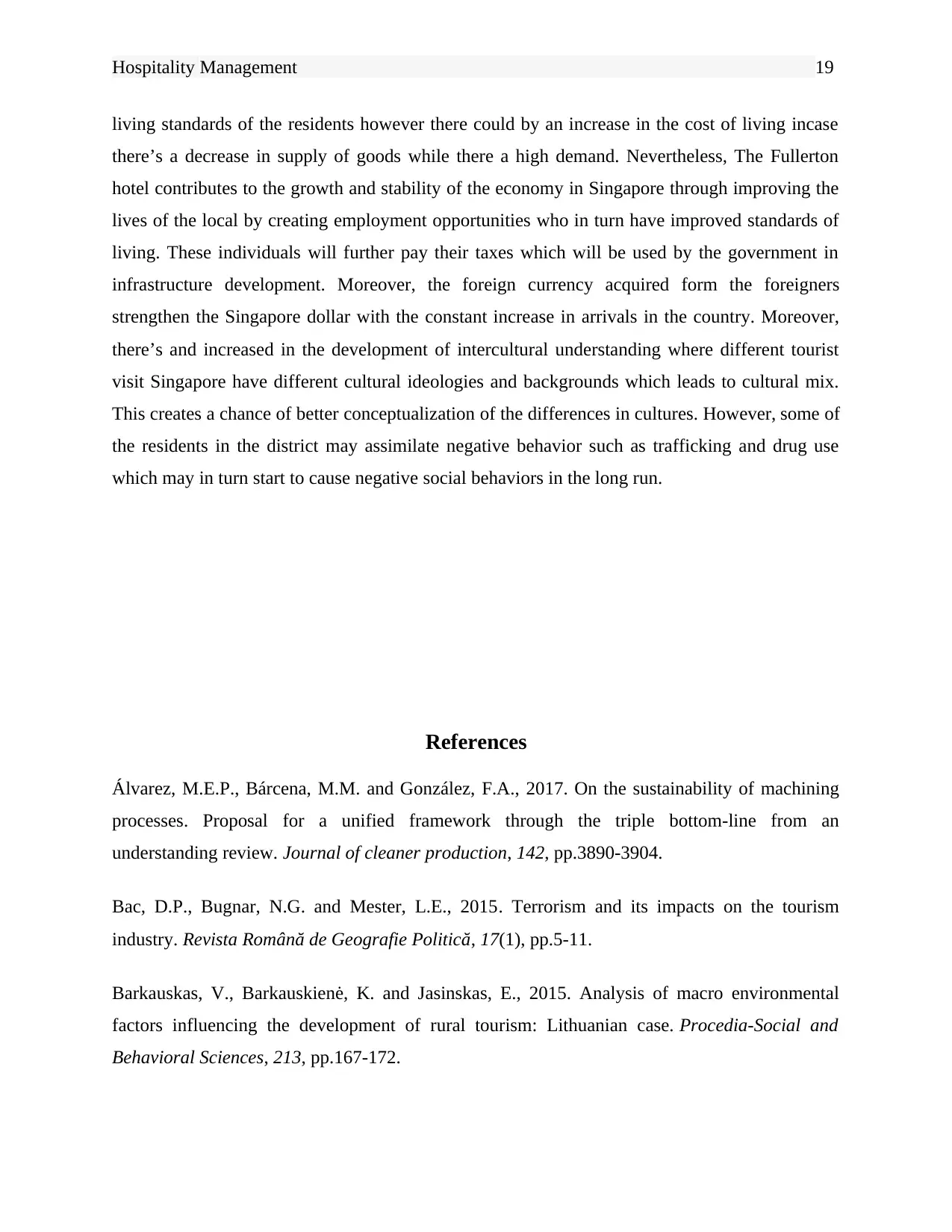
Hospitality Management 19
living standards of the residents however there could by an increase in the cost of living incase
there’s a decrease in supply of goods while there a high demand. Nevertheless, The Fullerton
hotel contributes to the growth and stability of the economy in Singapore through improving the
lives of the local by creating employment opportunities who in turn have improved standards of
living. These individuals will further pay their taxes which will be used by the government in
infrastructure development. Moreover, the foreign currency acquired form the foreigners
strengthen the Singapore dollar with the constant increase in arrivals in the country. Moreover,
there’s and increased in the development of intercultural understanding where different tourist
visit Singapore have different cultural ideologies and backgrounds which leads to cultural mix.
This creates a chance of better conceptualization of the differences in cultures. However, some of
the residents in the district may assimilate negative behavior such as trafficking and drug use
which may in turn start to cause negative social behaviors in the long run.
References
Álvarez, M.E.P., Bárcena, M.M. and González, F.A., 2017. On the sustainability of machining
processes. Proposal for a unified framework through the triple bottom-line from an
understanding review. Journal of cleaner production, 142, pp.3890-3904.
Bac, D.P., Bugnar, N.G. and Mester, L.E., 2015. Terrorism and its impacts on the tourism
industry. Revista Română de Geografie Politică, 17(1), pp.5-11.
Barkauskas, V., Barkauskienė, K. and Jasinskas, E., 2015. Analysis of macro environmental
factors influencing the development of rural tourism: Lithuanian case. Procedia-Social and
Behavioral Sciences, 213, pp.167-172.
living standards of the residents however there could by an increase in the cost of living incase
there’s a decrease in supply of goods while there a high demand. Nevertheless, The Fullerton
hotel contributes to the growth and stability of the economy in Singapore through improving the
lives of the local by creating employment opportunities who in turn have improved standards of
living. These individuals will further pay their taxes which will be used by the government in
infrastructure development. Moreover, the foreign currency acquired form the foreigners
strengthen the Singapore dollar with the constant increase in arrivals in the country. Moreover,
there’s and increased in the development of intercultural understanding where different tourist
visit Singapore have different cultural ideologies and backgrounds which leads to cultural mix.
This creates a chance of better conceptualization of the differences in cultures. However, some of
the residents in the district may assimilate negative behavior such as trafficking and drug use
which may in turn start to cause negative social behaviors in the long run.
References
Álvarez, M.E.P., Bárcena, M.M. and González, F.A., 2017. On the sustainability of machining
processes. Proposal for a unified framework through the triple bottom-line from an
understanding review. Journal of cleaner production, 142, pp.3890-3904.
Bac, D.P., Bugnar, N.G. and Mester, L.E., 2015. Terrorism and its impacts on the tourism
industry. Revista Română de Geografie Politică, 17(1), pp.5-11.
Barkauskas, V., Barkauskienė, K. and Jasinskas, E., 2015. Analysis of macro environmental
factors influencing the development of rural tourism: Lithuanian case. Procedia-Social and
Behavioral Sciences, 213, pp.167-172.
Paraphrase This Document
Need a fresh take? Get an instant paraphrase of this document with our AI Paraphraser
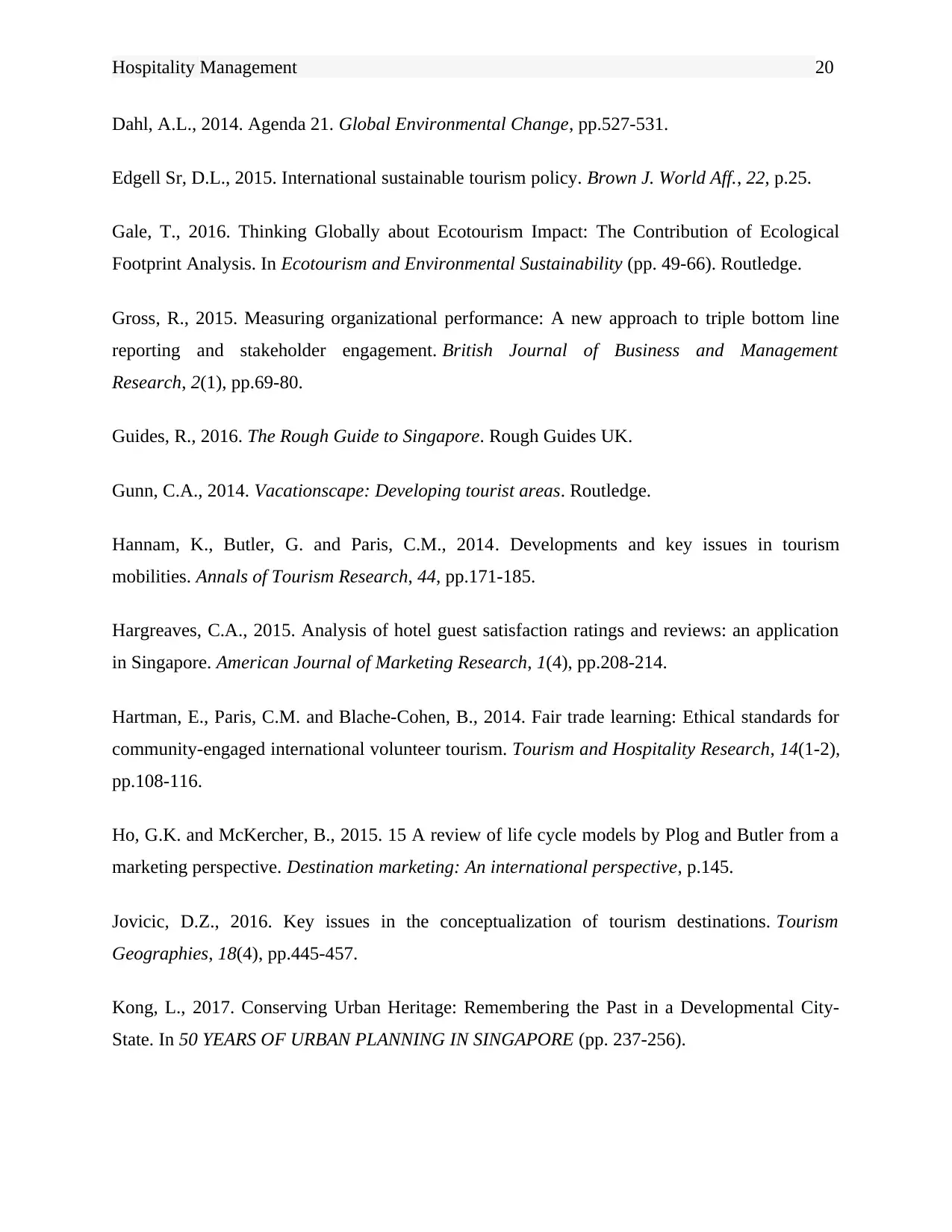
Hospitality Management 20
Dahl, A.L., 2014. Agenda 21. Global Environmental Change, pp.527-531.
Edgell Sr, D.L., 2015. International sustainable tourism policy. Brown J. World Aff., 22, p.25.
Gale, T., 2016. Thinking Globally about Ecotourism Impact: The Contribution of Ecological
Footprint Analysis. In Ecotourism and Environmental Sustainability (pp. 49-66). Routledge.
Gross, R., 2015. Measuring organizational performance: A new approach to triple bottom line
reporting and stakeholder engagement. British Journal of Business and Management
Research, 2(1), pp.69-80.
Guides, R., 2016. The Rough Guide to Singapore. Rough Guides UK.
Gunn, C.A., 2014. Vacationscape: Developing tourist areas. Routledge.
Hannam, K., Butler, G. and Paris, C.M., 2014. Developments and key issues in tourism
mobilities. Annals of Tourism Research, 44, pp.171-185.
Hargreaves, C.A., 2015. Analysis of hotel guest satisfaction ratings and reviews: an application
in Singapore. American Journal of Marketing Research, 1(4), pp.208-214.
Hartman, E., Paris, C.M. and Blache-Cohen, B., 2014. Fair trade learning: Ethical standards for
community-engaged international volunteer tourism. Tourism and Hospitality Research, 14(1-2),
pp.108-116.
Ho, G.K. and McKercher, B., 2015. 15 A review of life cycle models by Plog and Butler from a
marketing perspective. Destination marketing: An international perspective, p.145.
Jovicic, D.Z., 2016. Key issues in the conceptualization of tourism destinations. Tourism
Geographies, 18(4), pp.445-457.
Kong, L., 2017. Conserving Urban Heritage: Remembering the Past in a Developmental City-
State. In 50 YEARS OF URBAN PLANNING IN SINGAPORE (pp. 237-256).
Dahl, A.L., 2014. Agenda 21. Global Environmental Change, pp.527-531.
Edgell Sr, D.L., 2015. International sustainable tourism policy. Brown J. World Aff., 22, p.25.
Gale, T., 2016. Thinking Globally about Ecotourism Impact: The Contribution of Ecological
Footprint Analysis. In Ecotourism and Environmental Sustainability (pp. 49-66). Routledge.
Gross, R., 2015. Measuring organizational performance: A new approach to triple bottom line
reporting and stakeholder engagement. British Journal of Business and Management
Research, 2(1), pp.69-80.
Guides, R., 2016. The Rough Guide to Singapore. Rough Guides UK.
Gunn, C.A., 2014. Vacationscape: Developing tourist areas. Routledge.
Hannam, K., Butler, G. and Paris, C.M., 2014. Developments and key issues in tourism
mobilities. Annals of Tourism Research, 44, pp.171-185.
Hargreaves, C.A., 2015. Analysis of hotel guest satisfaction ratings and reviews: an application
in Singapore. American Journal of Marketing Research, 1(4), pp.208-214.
Hartman, E., Paris, C.M. and Blache-Cohen, B., 2014. Fair trade learning: Ethical standards for
community-engaged international volunteer tourism. Tourism and Hospitality Research, 14(1-2),
pp.108-116.
Ho, G.K. and McKercher, B., 2015. 15 A review of life cycle models by Plog and Butler from a
marketing perspective. Destination marketing: An international perspective, p.145.
Jovicic, D.Z., 2016. Key issues in the conceptualization of tourism destinations. Tourism
Geographies, 18(4), pp.445-457.
Kong, L., 2017. Conserving Urban Heritage: Remembering the Past in a Developmental City-
State. In 50 YEARS OF URBAN PLANNING IN SINGAPORE (pp. 237-256).
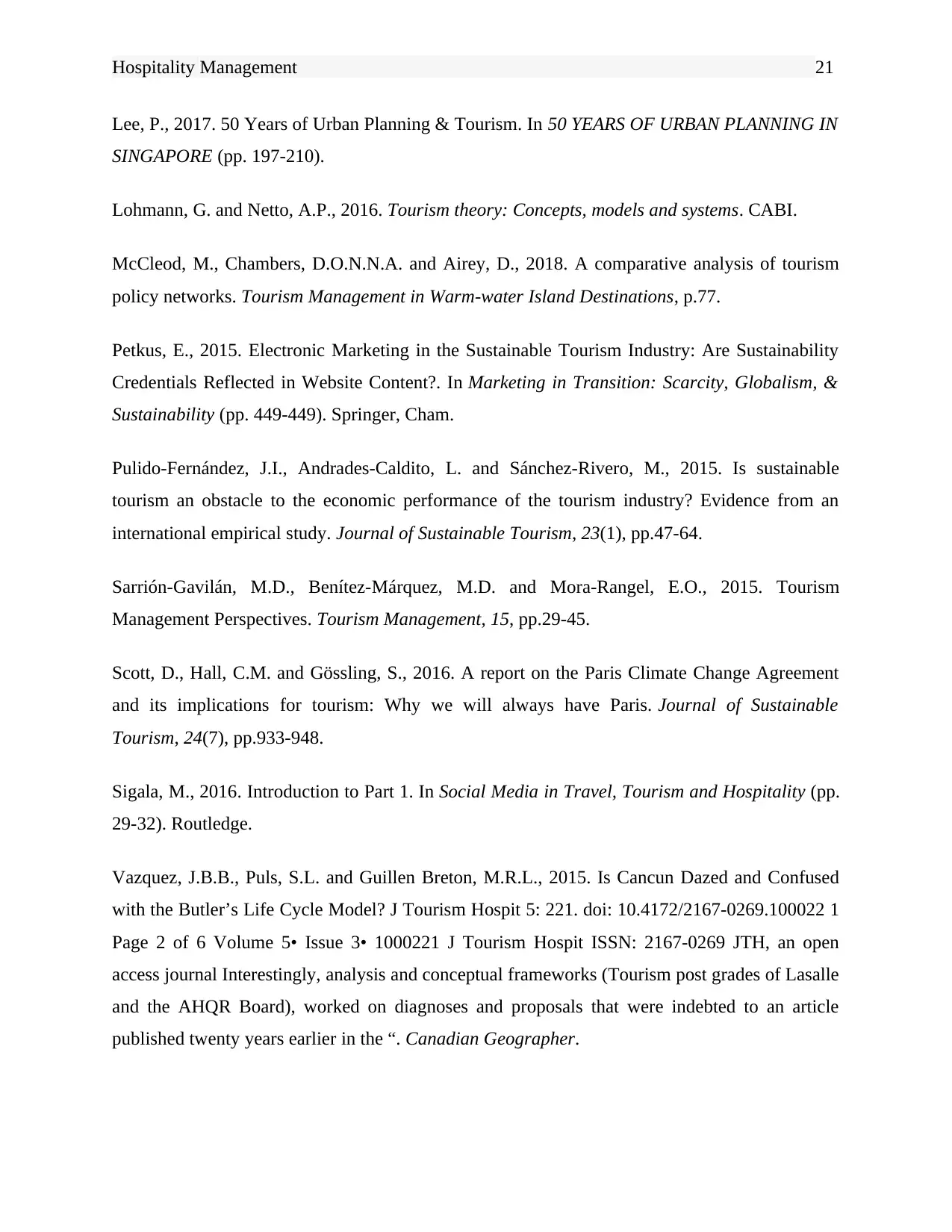
Hospitality Management 21
Lee, P., 2017. 50 Years of Urban Planning & Tourism. In 50 YEARS OF URBAN PLANNING IN
SINGAPORE (pp. 197-210).
Lohmann, G. and Netto, A.P., 2016. Tourism theory: Concepts, models and systems. CABI.
McCleod, M., Chambers, D.O.N.N.A. and Airey, D., 2018. A comparative analysis of tourism
policy networks. Tourism Management in Warm-water Island Destinations, p.77.
Petkus, E., 2015. Electronic Marketing in the Sustainable Tourism Industry: Are Sustainability
Credentials Reflected in Website Content?. In Marketing in Transition: Scarcity, Globalism, &
Sustainability (pp. 449-449). Springer, Cham.
Pulido-Fernández, J.I., Andrades-Caldito, L. and Sánchez-Rivero, M., 2015. Is sustainable
tourism an obstacle to the economic performance of the tourism industry? Evidence from an
international empirical study. Journal of Sustainable Tourism, 23(1), pp.47-64.
Sarrión-Gavilán, M.D., Benítez-Márquez, M.D. and Mora-Rangel, E.O., 2015. Tourism
Management Perspectives. Tourism Management, 15, pp.29-45.
Scott, D., Hall, C.M. and Gössling, S., 2016. A report on the Paris Climate Change Agreement
and its implications for tourism: Why we will always have Paris. Journal of Sustainable
Tourism, 24(7), pp.933-948.
Sigala, M., 2016. Introduction to Part 1. In Social Media in Travel, Tourism and Hospitality (pp.
29-32). Routledge.
Vazquez, J.B.B., Puls, S.L. and Guillen Breton, M.R.L., 2015. Is Cancun Dazed and Confused
with the Butler’s Life Cycle Model? J Tourism Hospit 5: 221. doi: 10.4172/2167-0269.100022 1
Page 2 of 6 Volume 5• Issue 3• 1000221 J Tourism Hospit ISSN: 2167-0269 JTH, an open
access journal Interestingly, analysis and conceptual frameworks (Tourism post grades of Lasalle
and the AHQR Board), worked on diagnoses and proposals that were indebted to an article
published twenty years earlier in the “. Canadian Geographer.
Lee, P., 2017. 50 Years of Urban Planning & Tourism. In 50 YEARS OF URBAN PLANNING IN
SINGAPORE (pp. 197-210).
Lohmann, G. and Netto, A.P., 2016. Tourism theory: Concepts, models and systems. CABI.
McCleod, M., Chambers, D.O.N.N.A. and Airey, D., 2018. A comparative analysis of tourism
policy networks. Tourism Management in Warm-water Island Destinations, p.77.
Petkus, E., 2015. Electronic Marketing in the Sustainable Tourism Industry: Are Sustainability
Credentials Reflected in Website Content?. In Marketing in Transition: Scarcity, Globalism, &
Sustainability (pp. 449-449). Springer, Cham.
Pulido-Fernández, J.I., Andrades-Caldito, L. and Sánchez-Rivero, M., 2015. Is sustainable
tourism an obstacle to the economic performance of the tourism industry? Evidence from an
international empirical study. Journal of Sustainable Tourism, 23(1), pp.47-64.
Sarrión-Gavilán, M.D., Benítez-Márquez, M.D. and Mora-Rangel, E.O., 2015. Tourism
Management Perspectives. Tourism Management, 15, pp.29-45.
Scott, D., Hall, C.M. and Gössling, S., 2016. A report on the Paris Climate Change Agreement
and its implications for tourism: Why we will always have Paris. Journal of Sustainable
Tourism, 24(7), pp.933-948.
Sigala, M., 2016. Introduction to Part 1. In Social Media in Travel, Tourism and Hospitality (pp.
29-32). Routledge.
Vazquez, J.B.B., Puls, S.L. and Guillen Breton, M.R.L., 2015. Is Cancun Dazed and Confused
with the Butler’s Life Cycle Model? J Tourism Hospit 5: 221. doi: 10.4172/2167-0269.100022 1
Page 2 of 6 Volume 5• Issue 3• 1000221 J Tourism Hospit ISSN: 2167-0269 JTH, an open
access journal Interestingly, analysis and conceptual frameworks (Tourism post grades of Lasalle
and the AHQR Board), worked on diagnoses and proposals that were indebted to an article
published twenty years earlier in the “. Canadian Geographer.
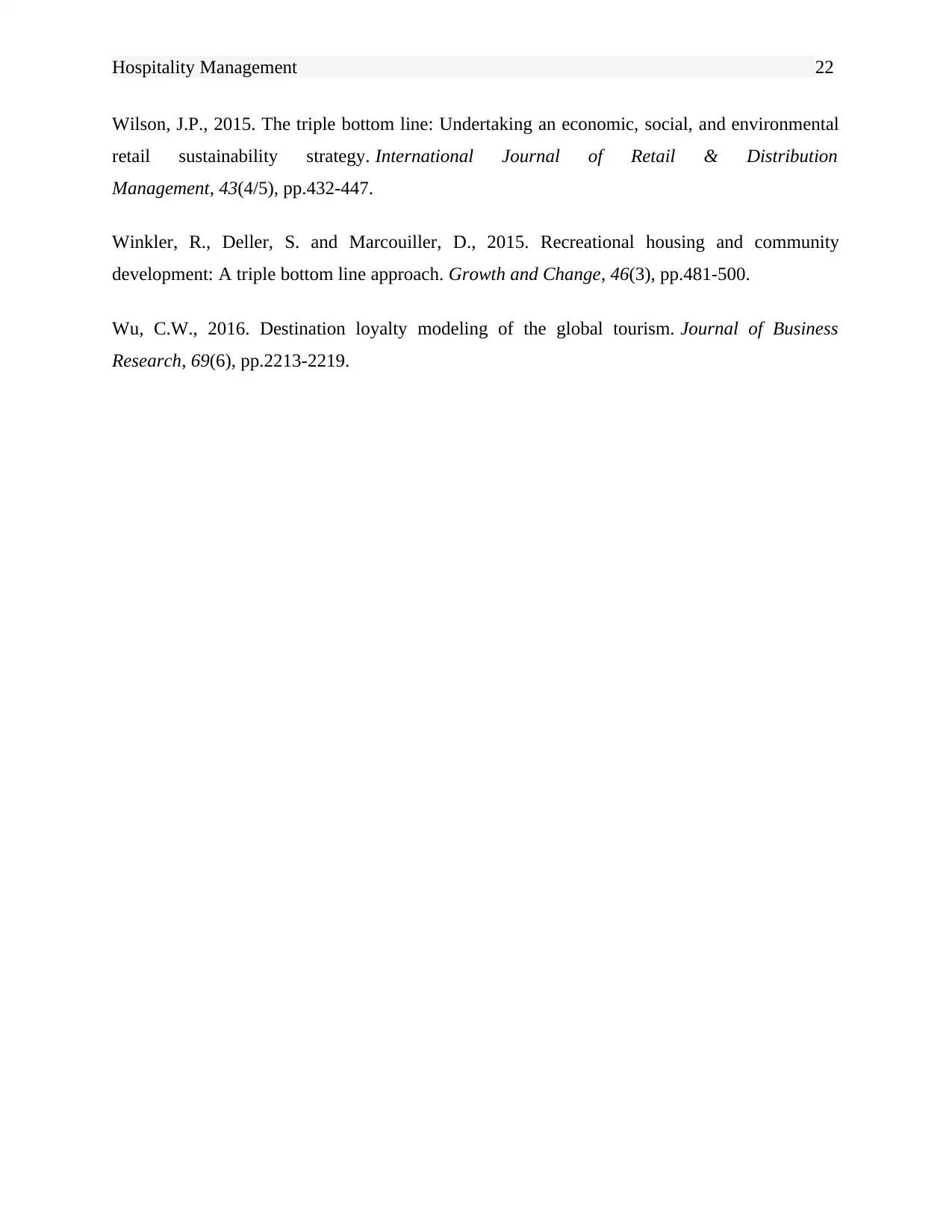
Hospitality Management 22
Wilson, J.P., 2015. The triple bottom line: Undertaking an economic, social, and environmental
retail sustainability strategy. International Journal of Retail & Distribution
Management, 43(4/5), pp.432-447.
Winkler, R., Deller, S. and Marcouiller, D., 2015. Recreational housing and community
development: A triple bottom line approach. Growth and Change, 46(3), pp.481-500.
Wu, C.W., 2016. Destination loyalty modeling of the global tourism. Journal of Business
Research, 69(6), pp.2213-2219.
Wilson, J.P., 2015. The triple bottom line: Undertaking an economic, social, and environmental
retail sustainability strategy. International Journal of Retail & Distribution
Management, 43(4/5), pp.432-447.
Winkler, R., Deller, S. and Marcouiller, D., 2015. Recreational housing and community
development: A triple bottom line approach. Growth and Change, 46(3), pp.481-500.
Wu, C.W., 2016. Destination loyalty modeling of the global tourism. Journal of Business
Research, 69(6), pp.2213-2219.
1 out of 22
Related Documents
Your All-in-One AI-Powered Toolkit for Academic Success.
+13062052269
info@desklib.com
Available 24*7 on WhatsApp / Email
![[object Object]](/_next/static/media/star-bottom.7253800d.svg)
Unlock your academic potential
© 2024 | Zucol Services PVT LTD | All rights reserved.





